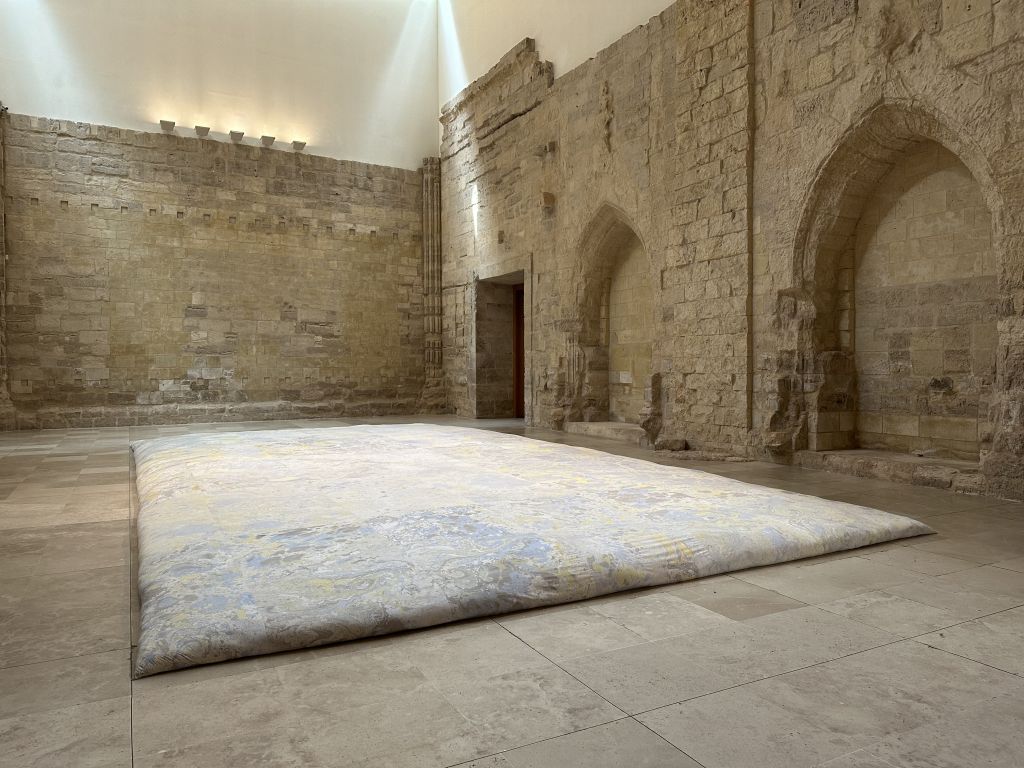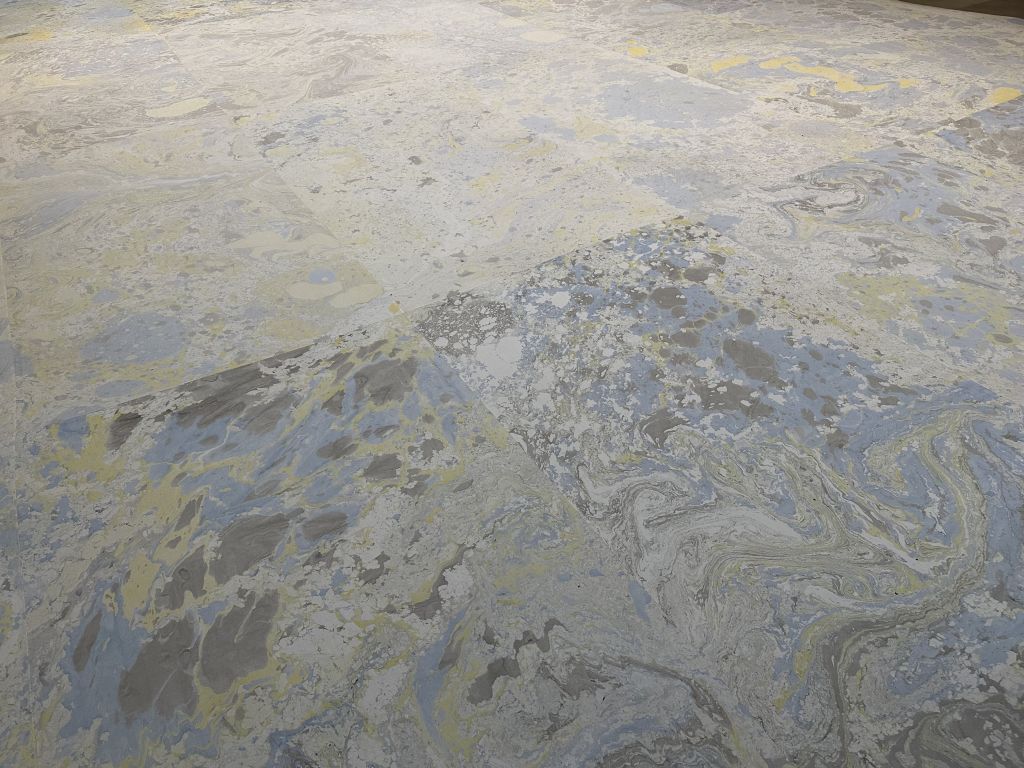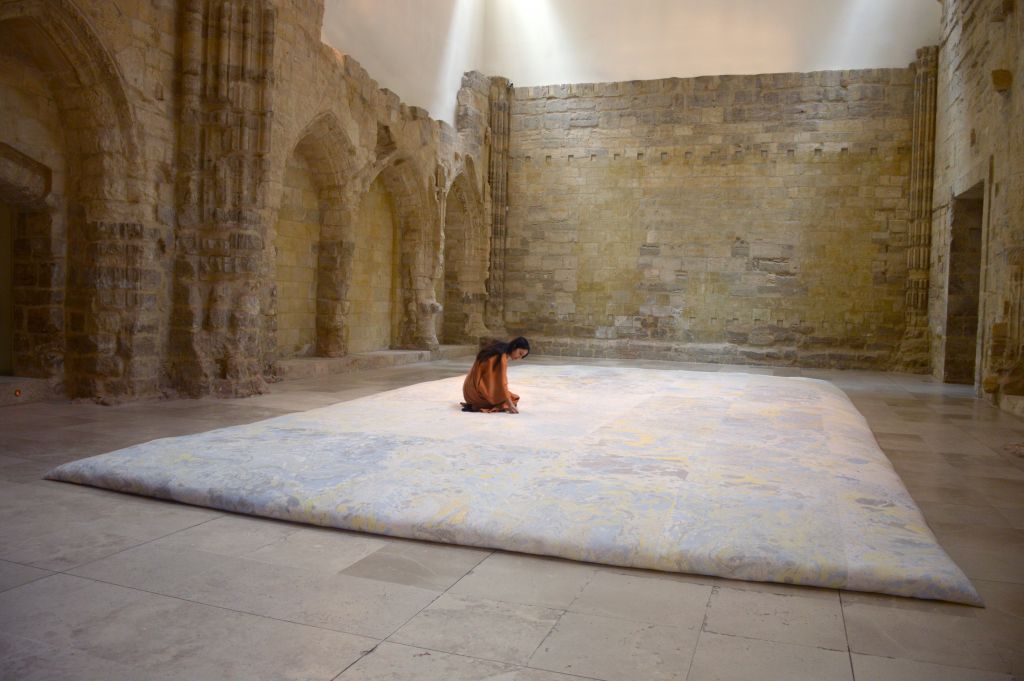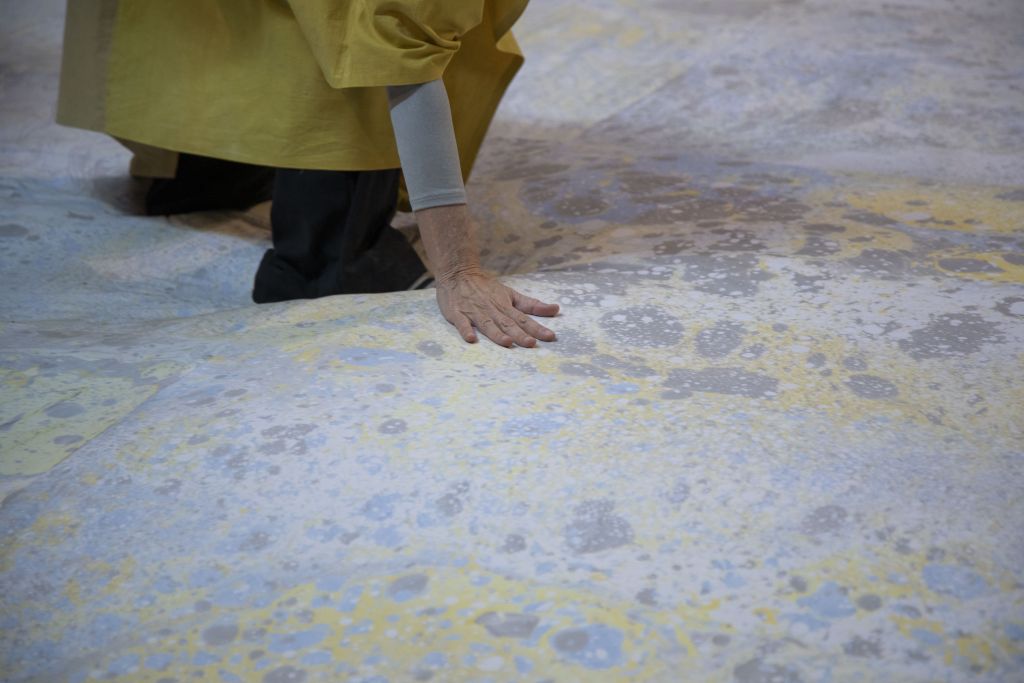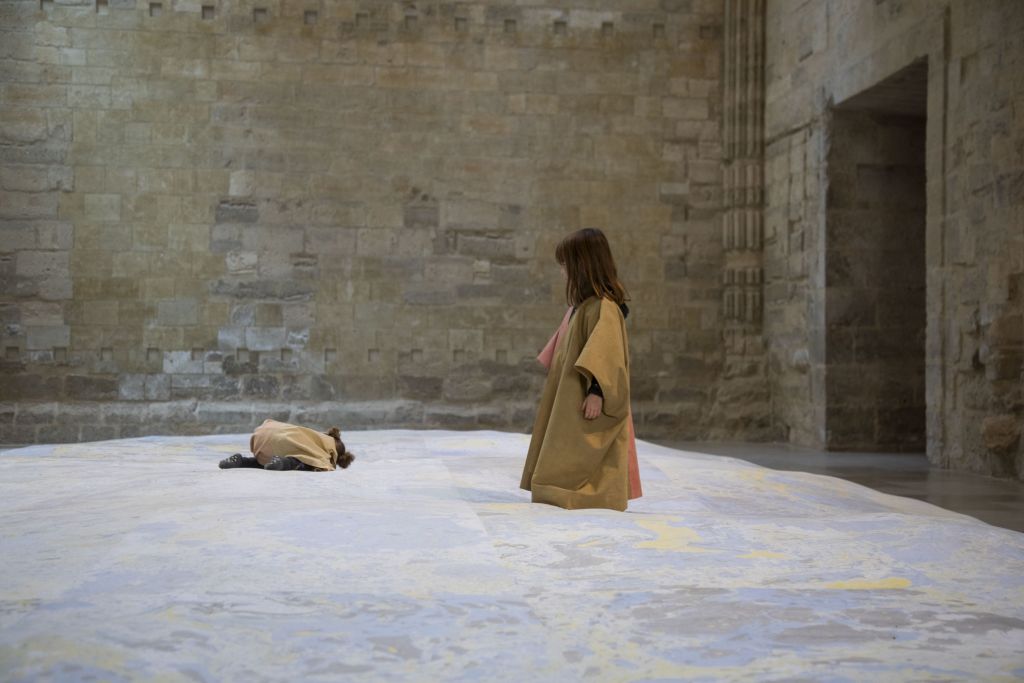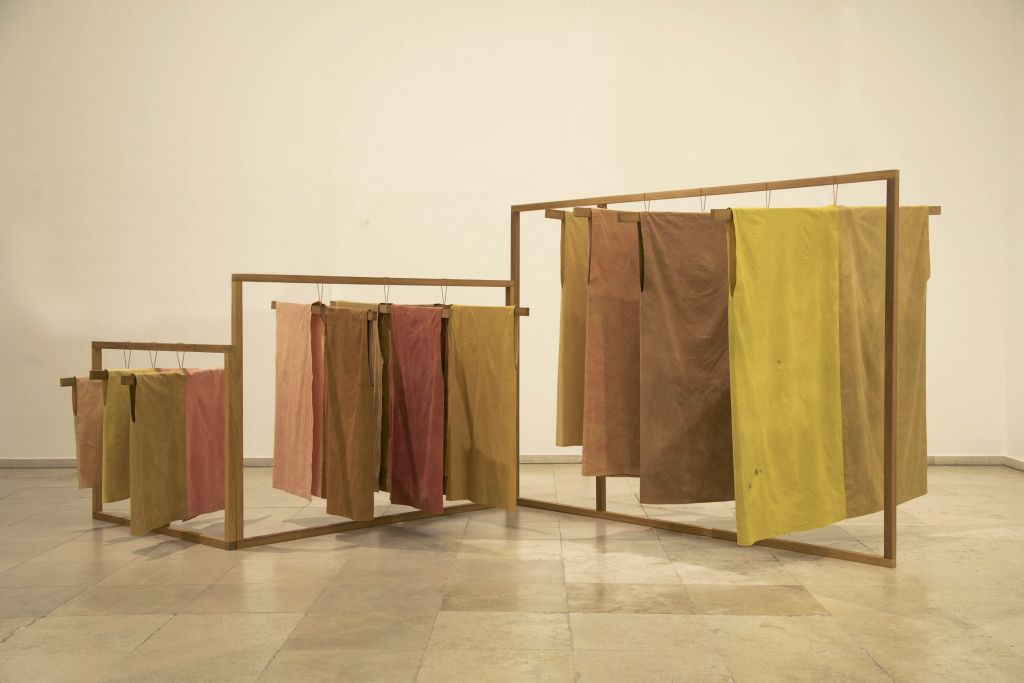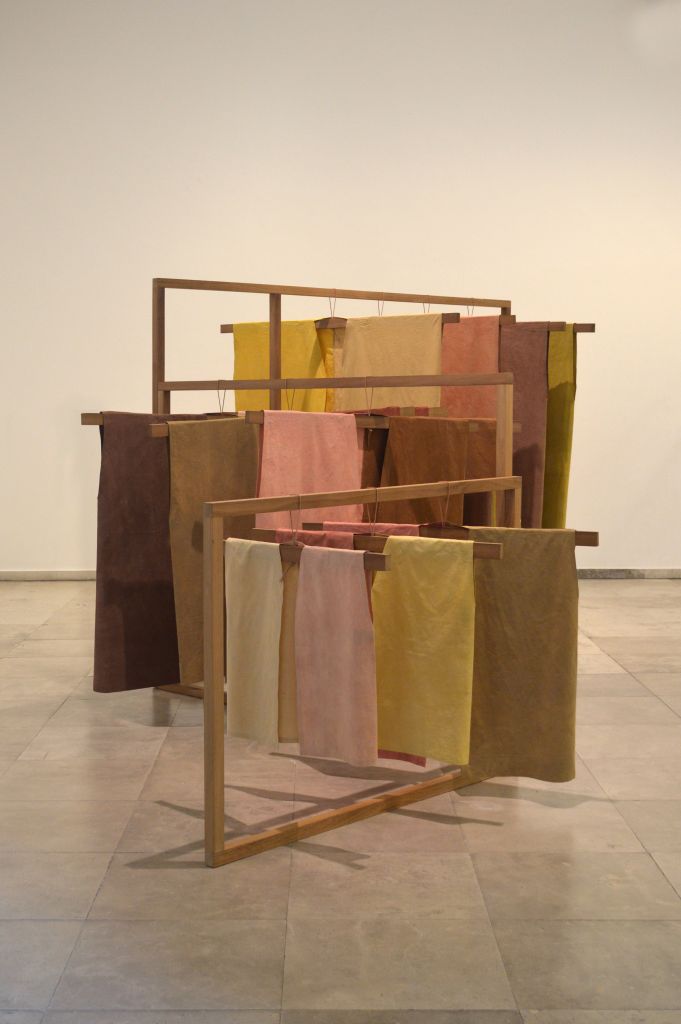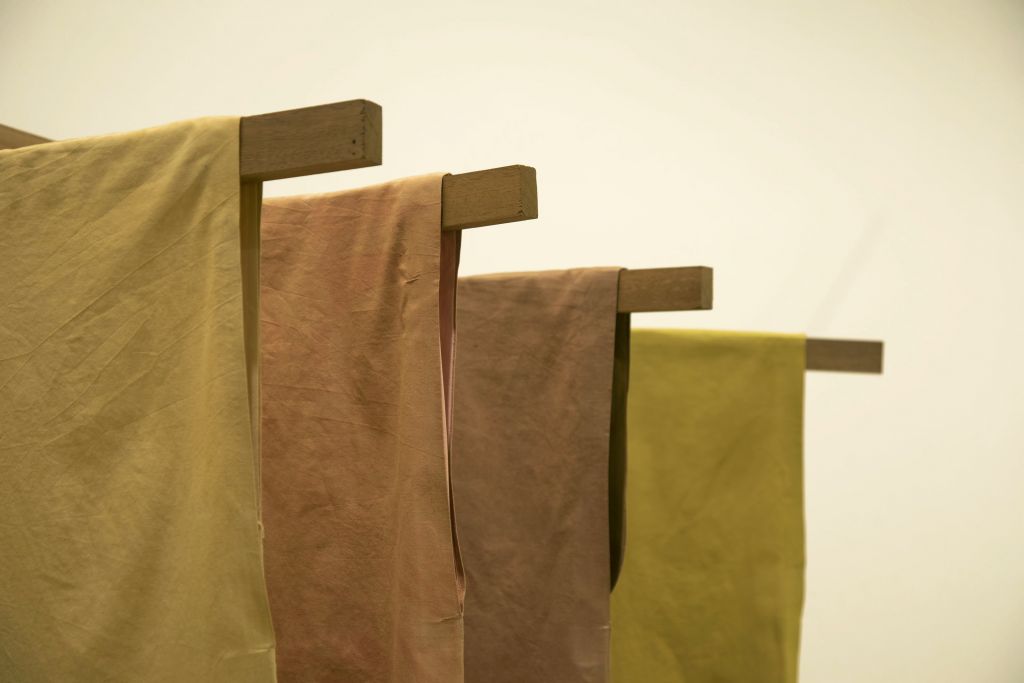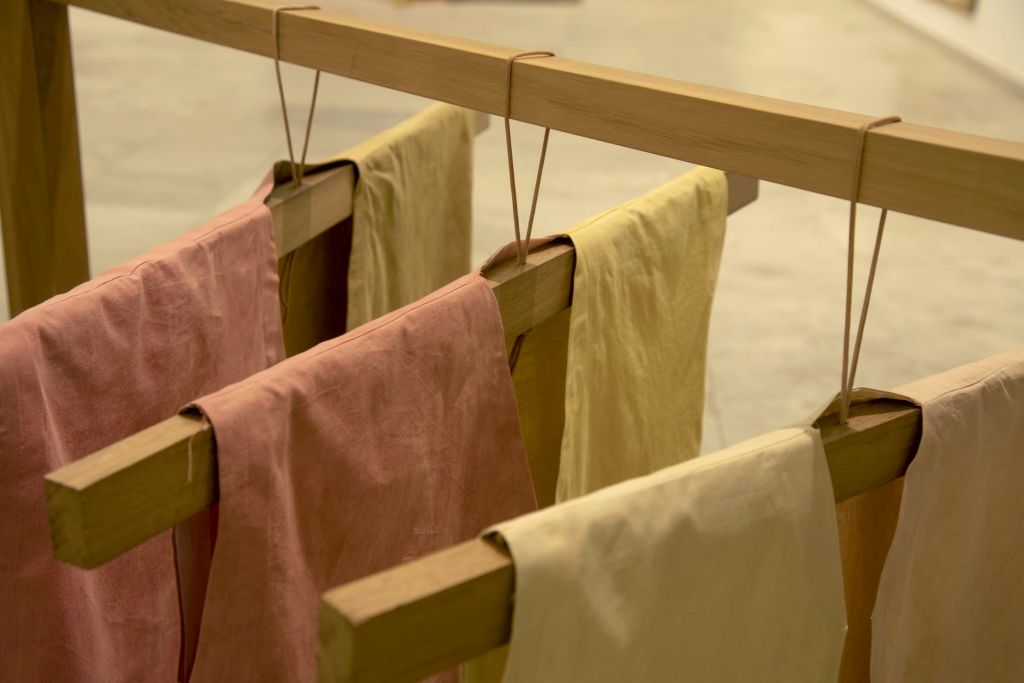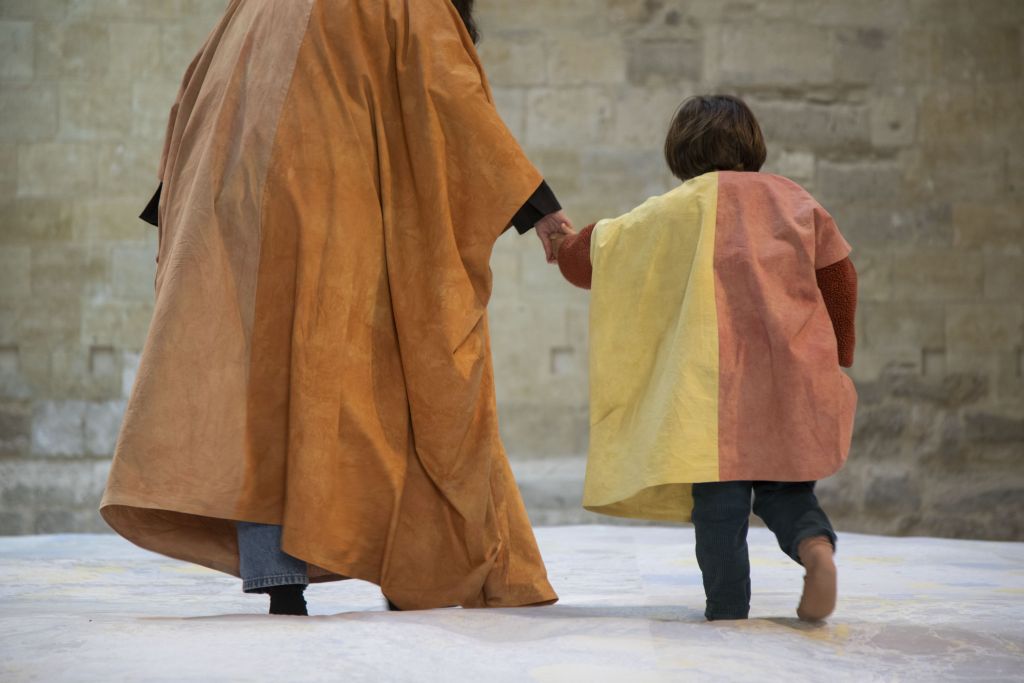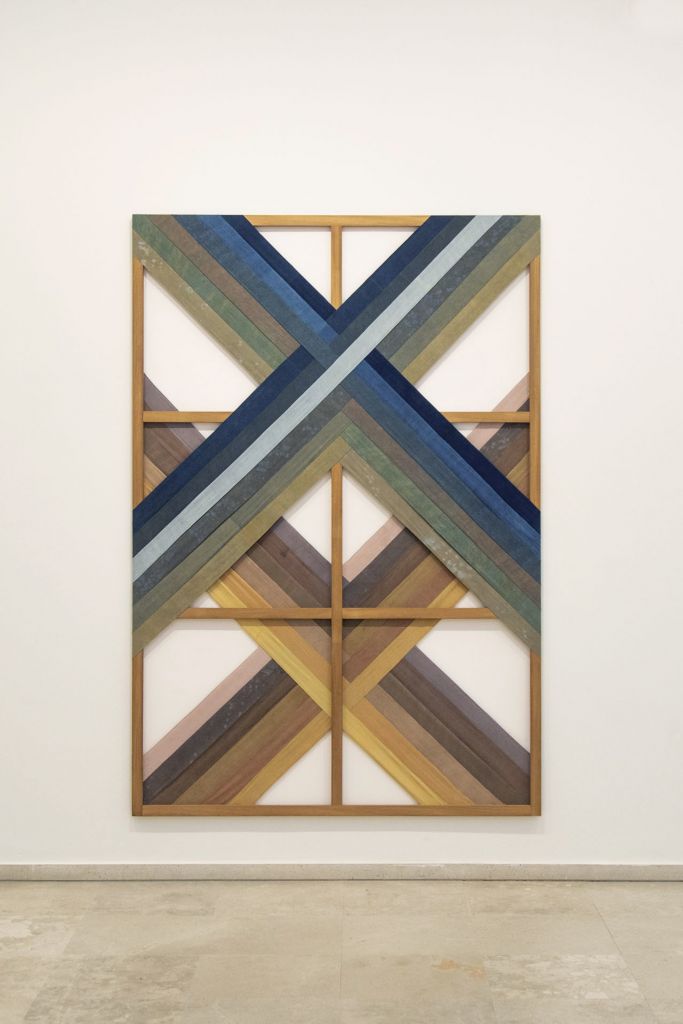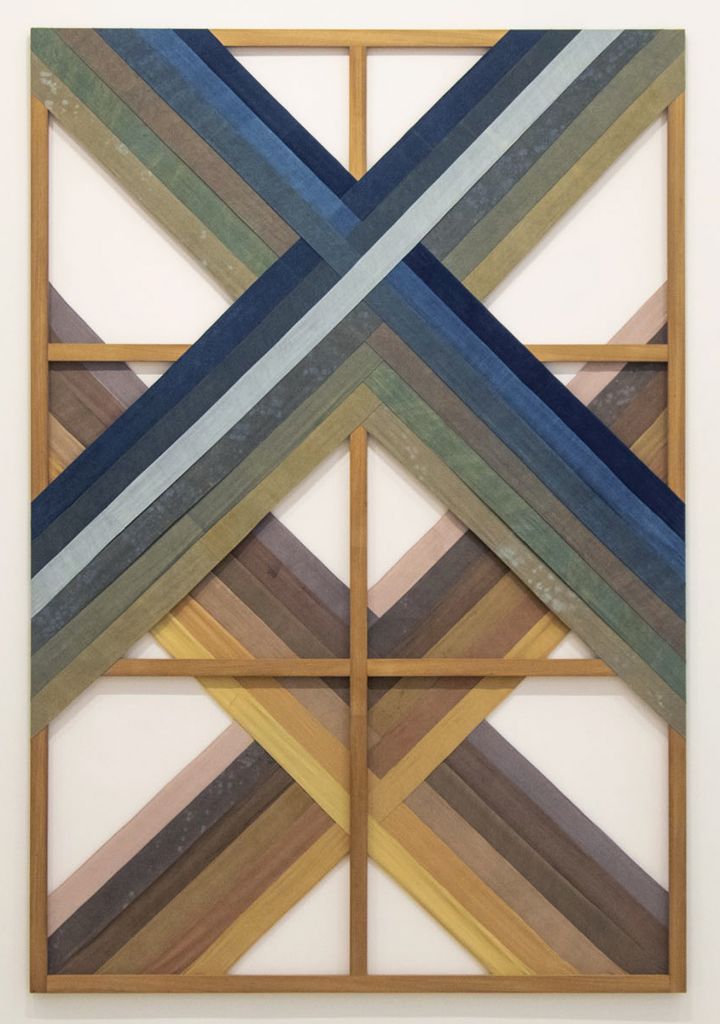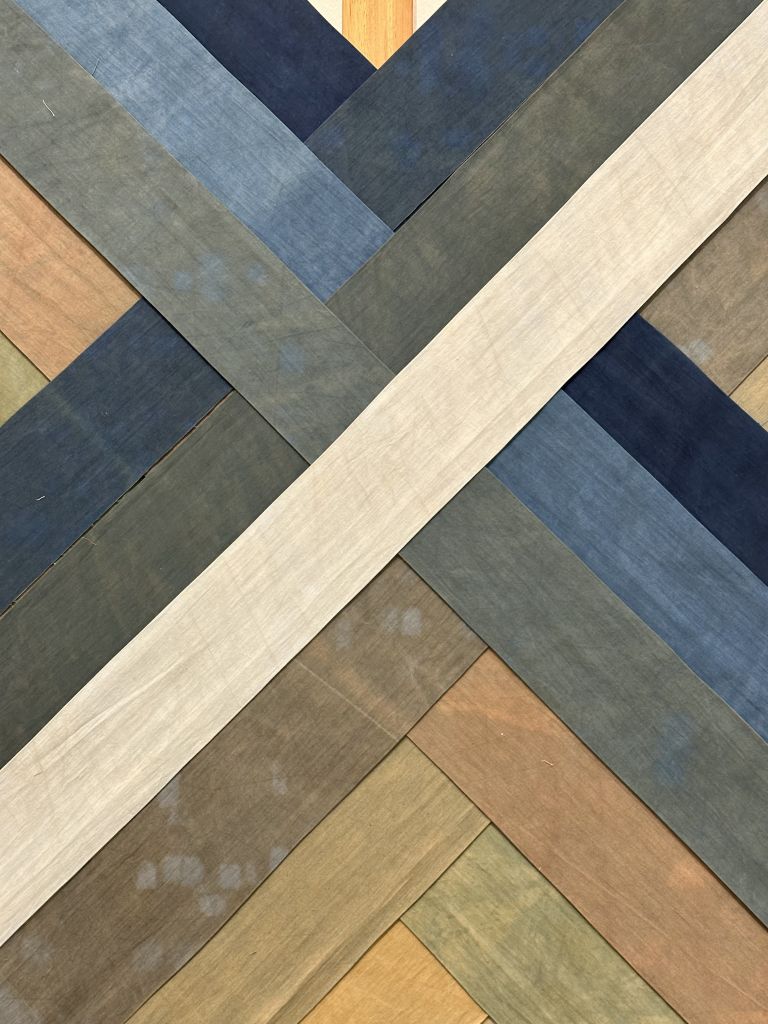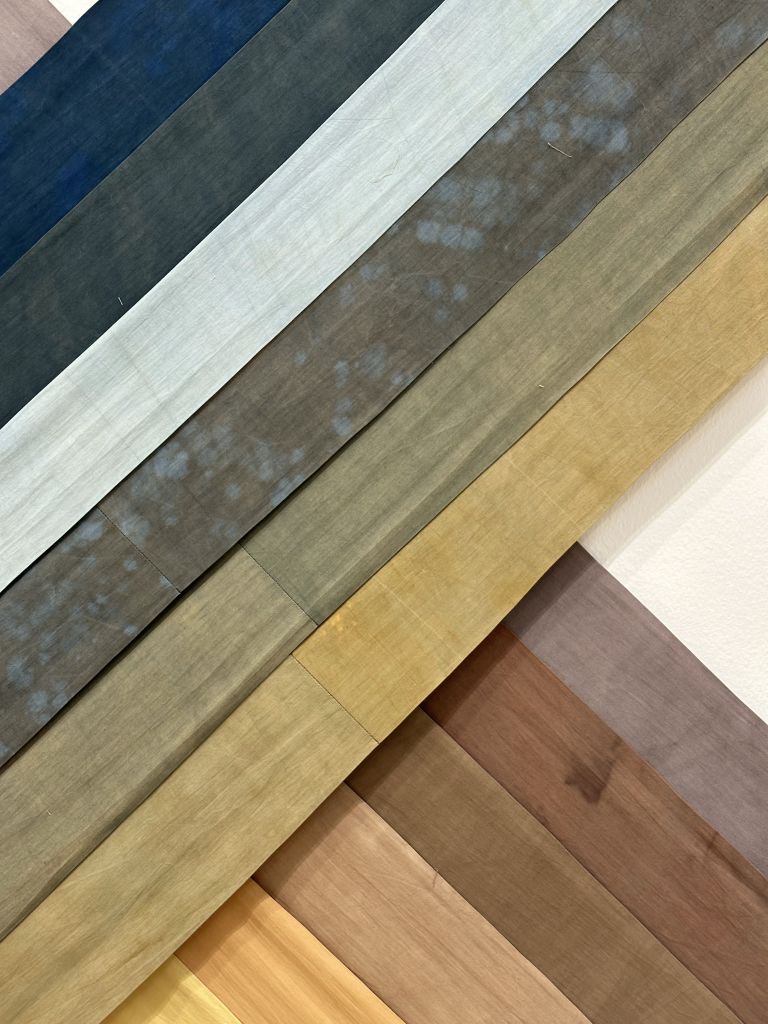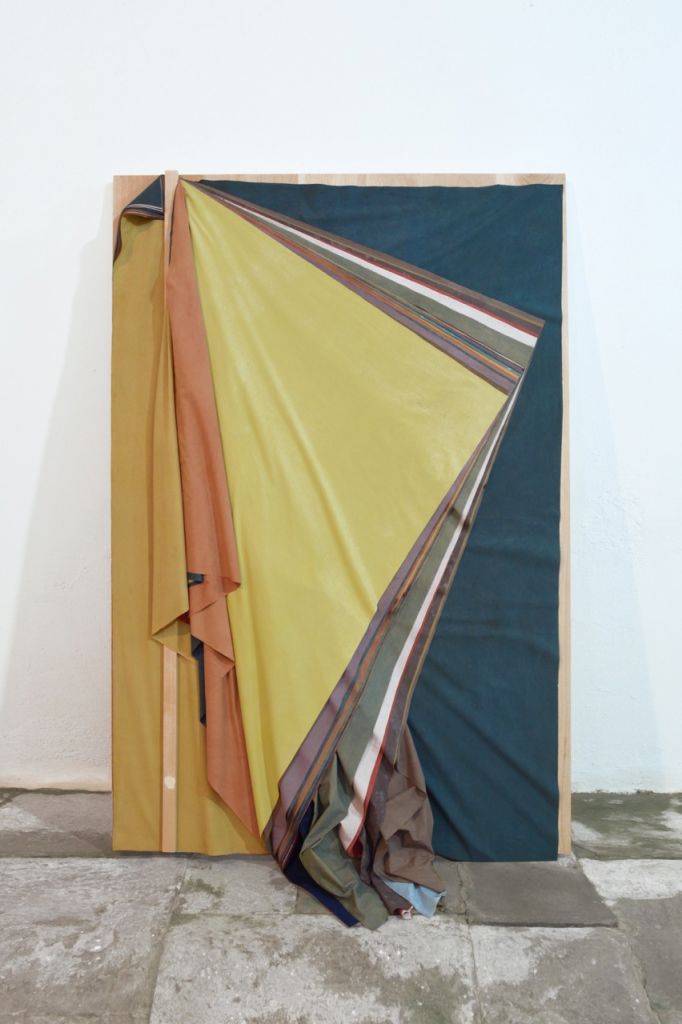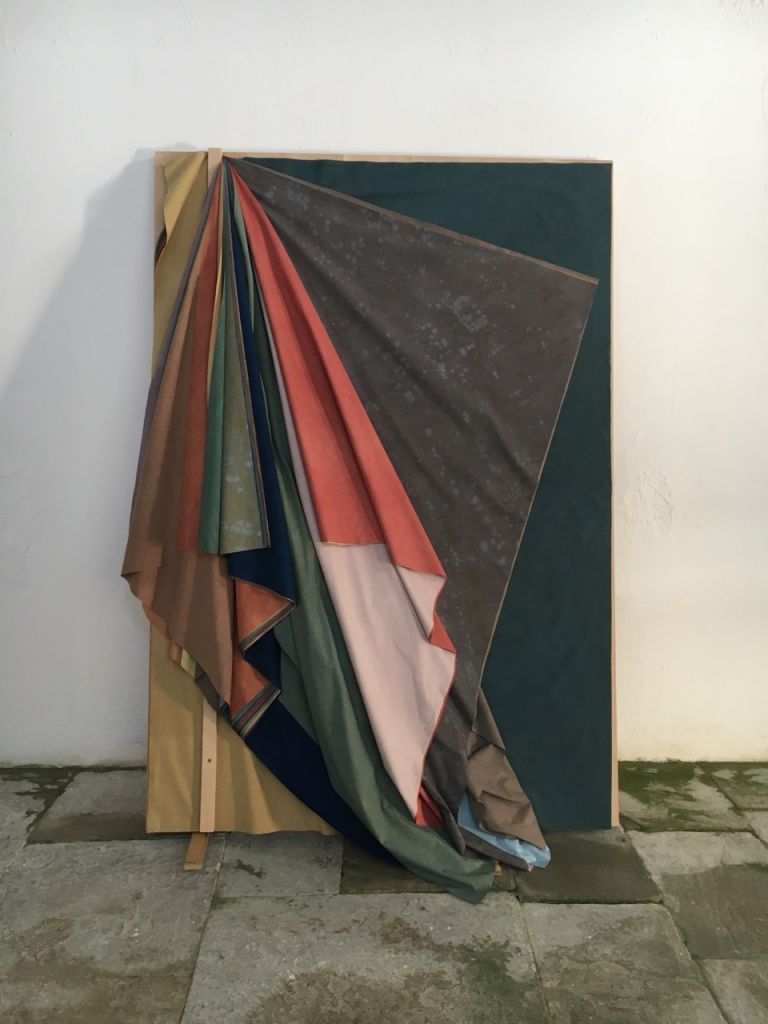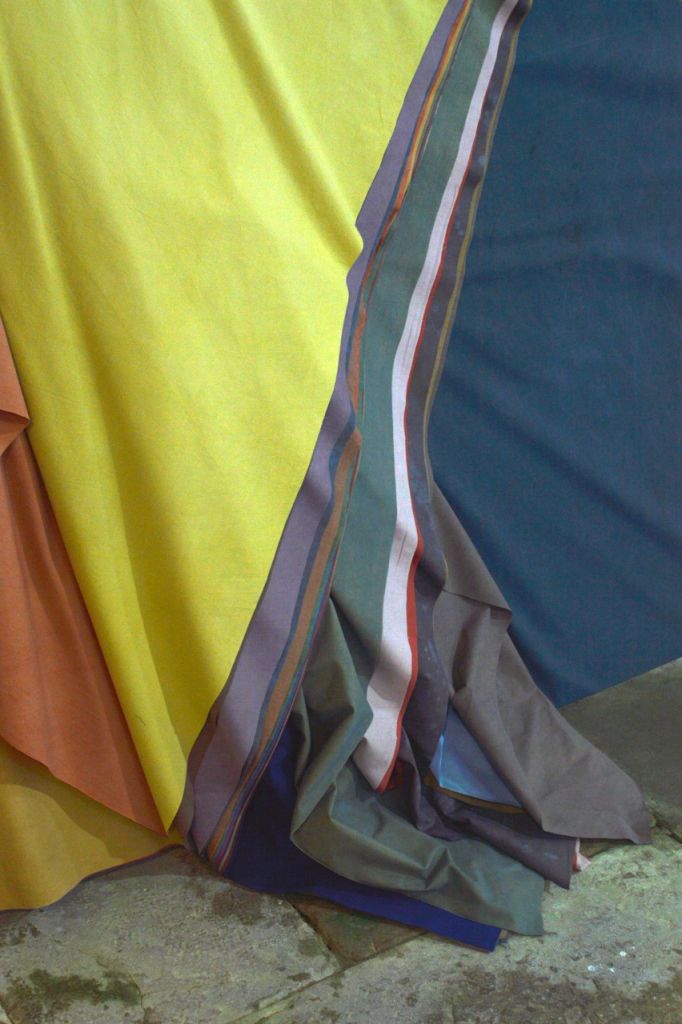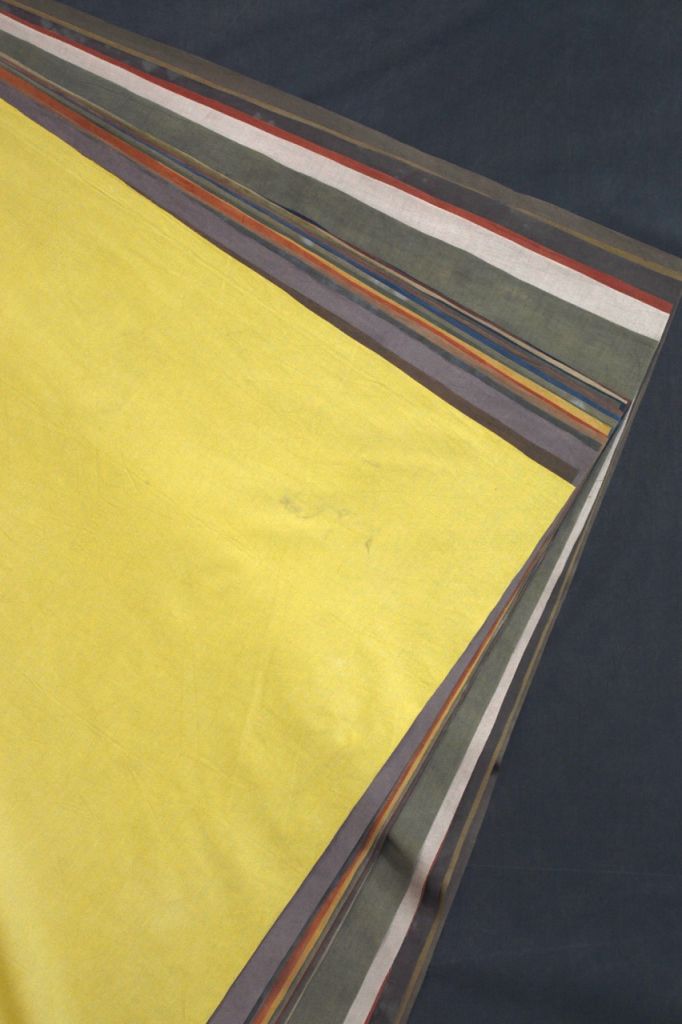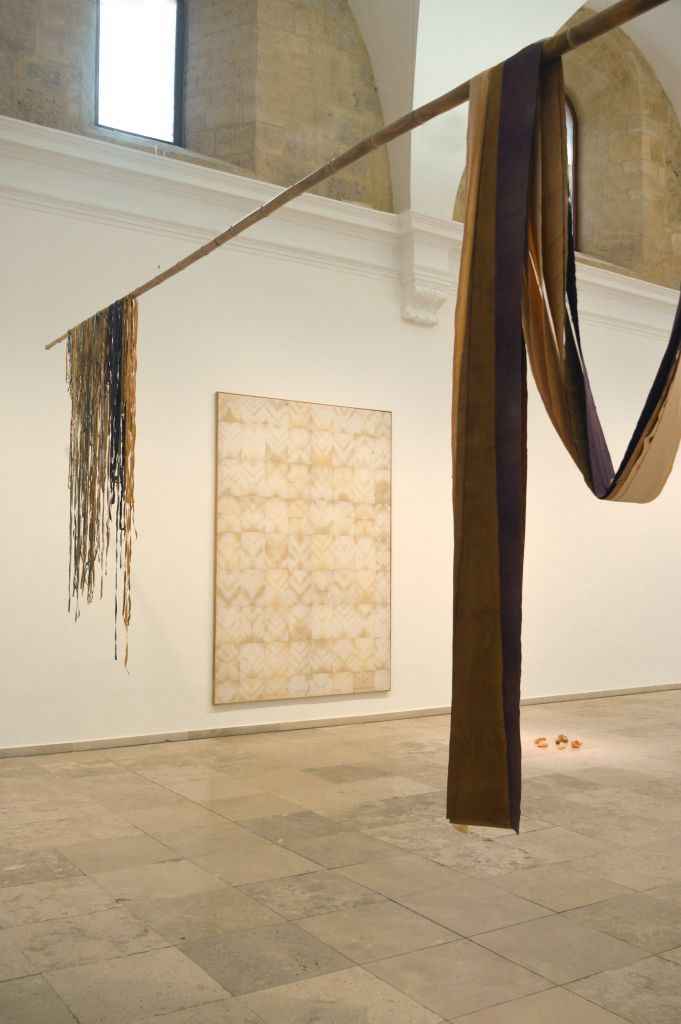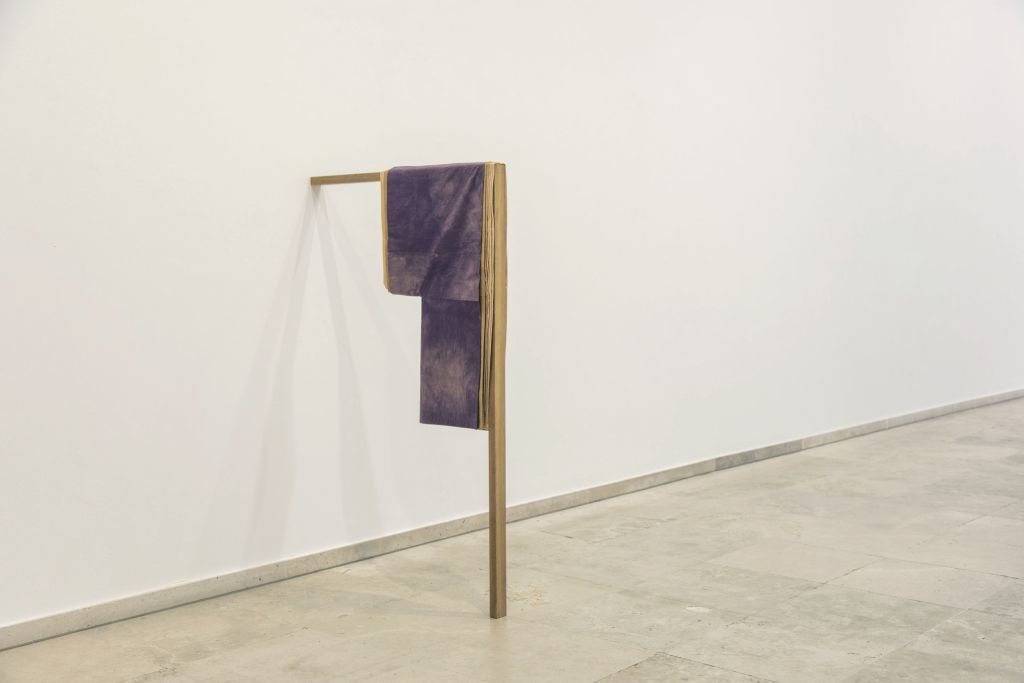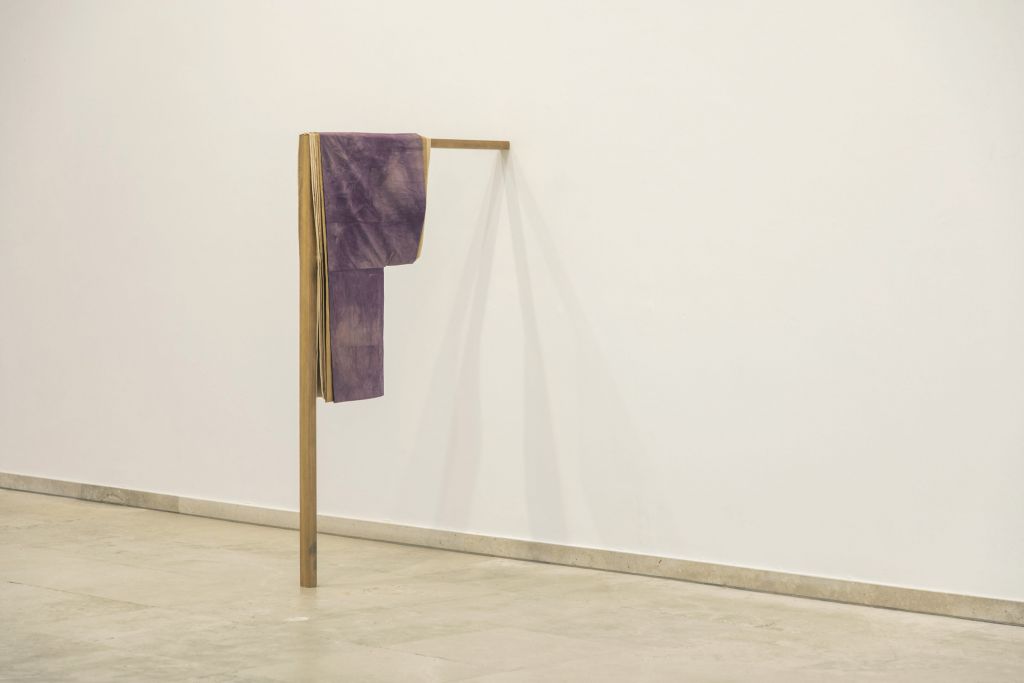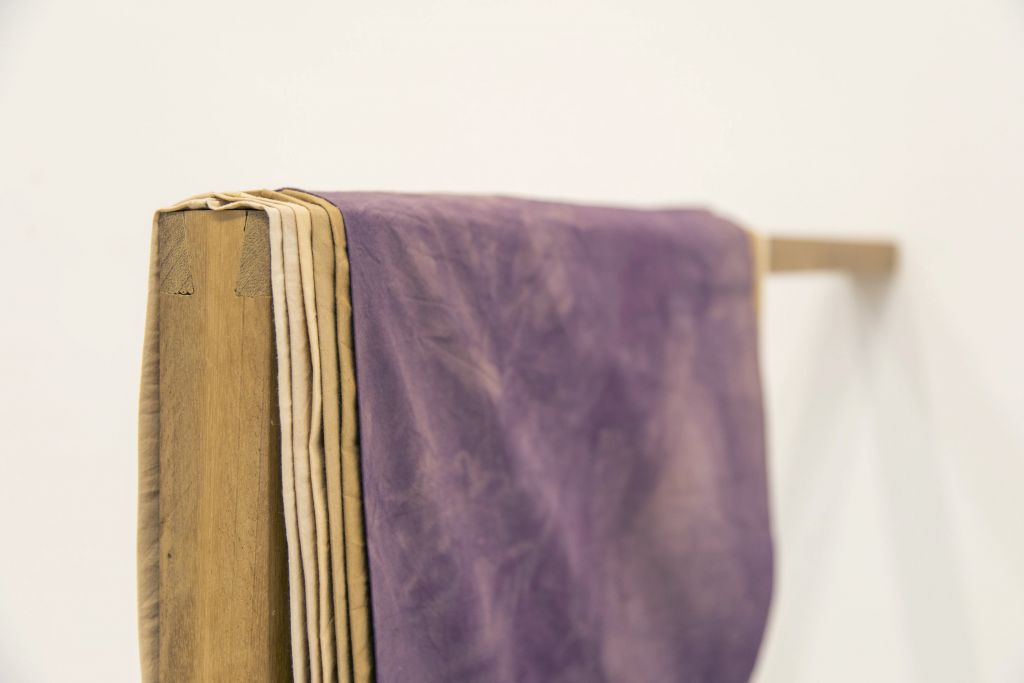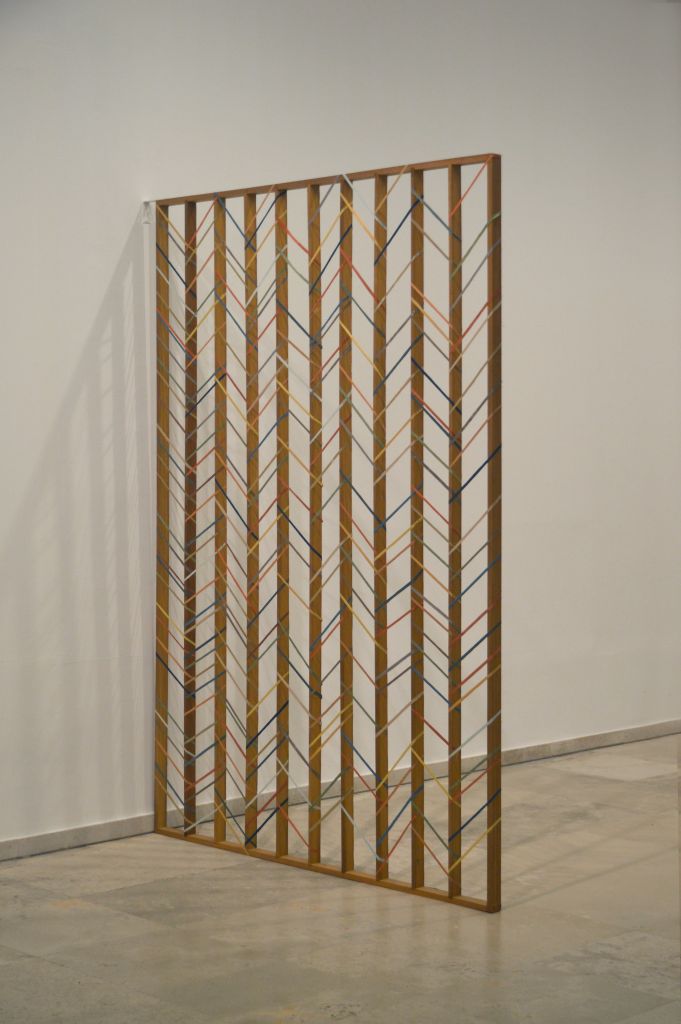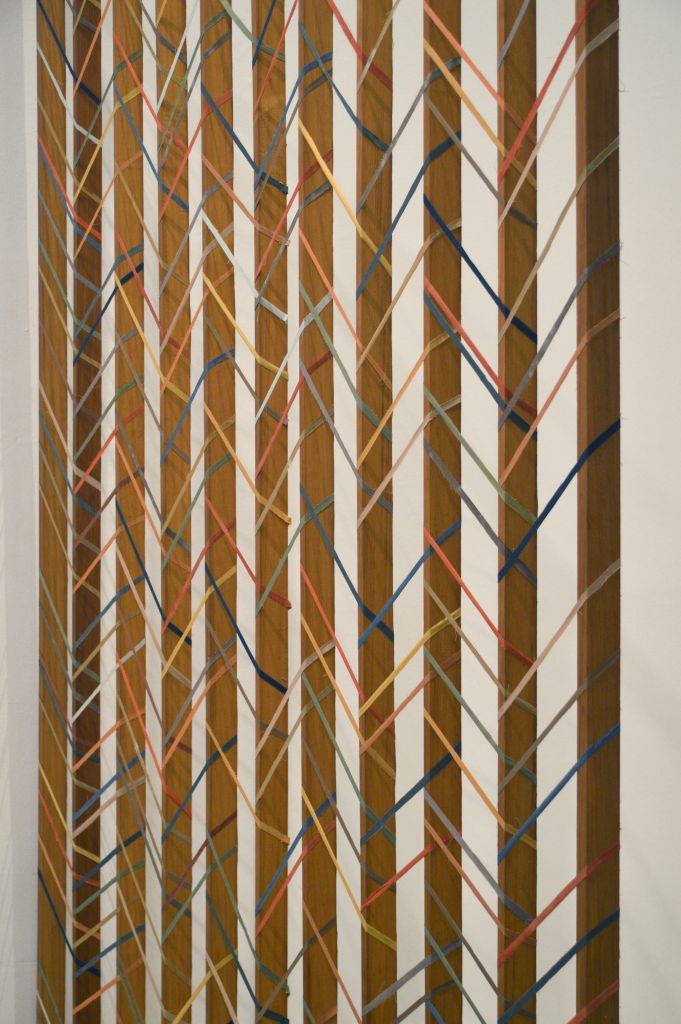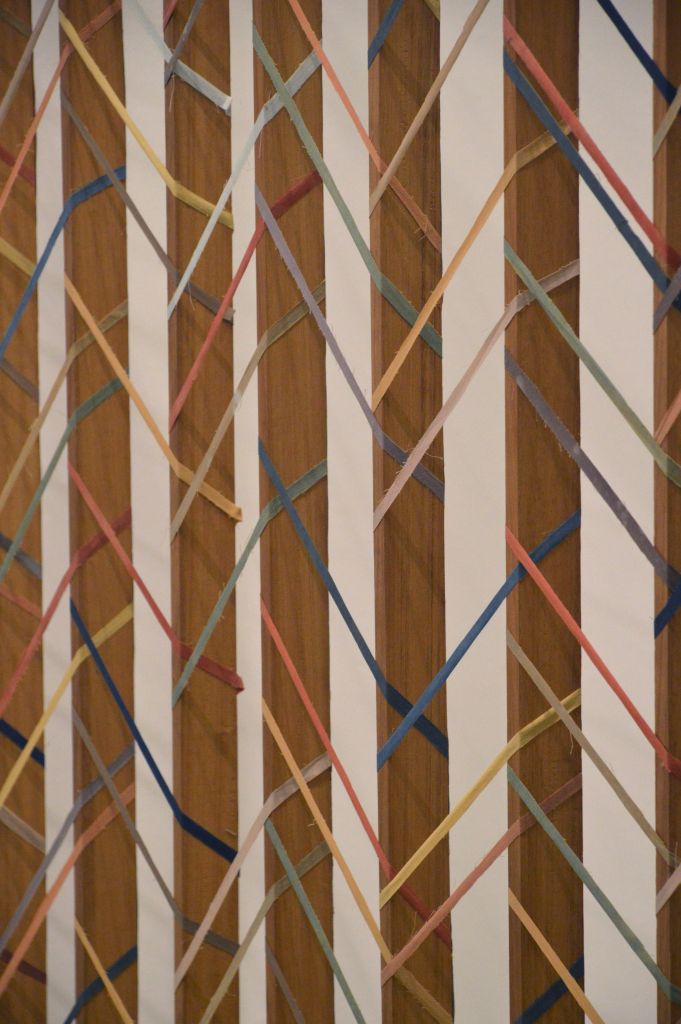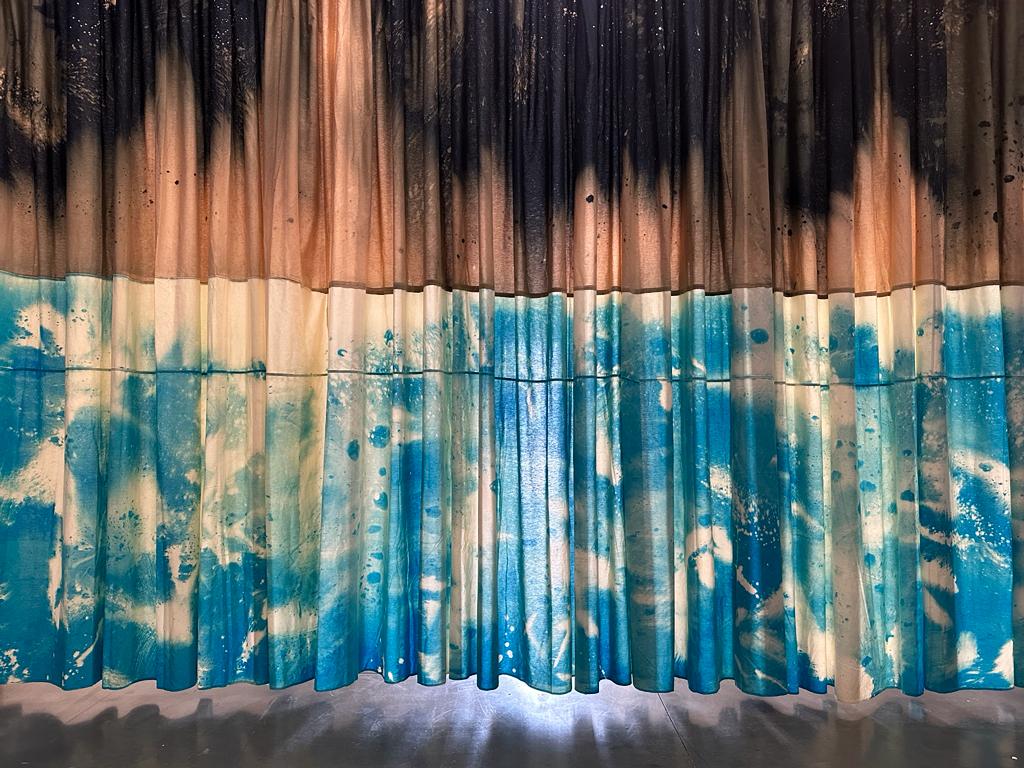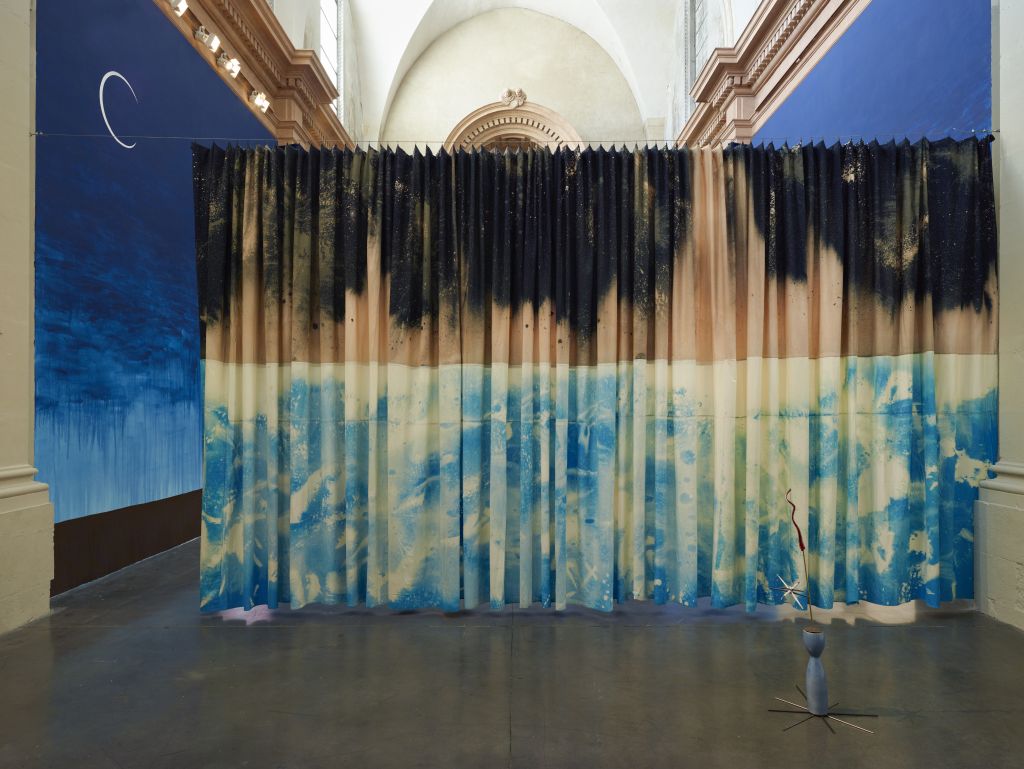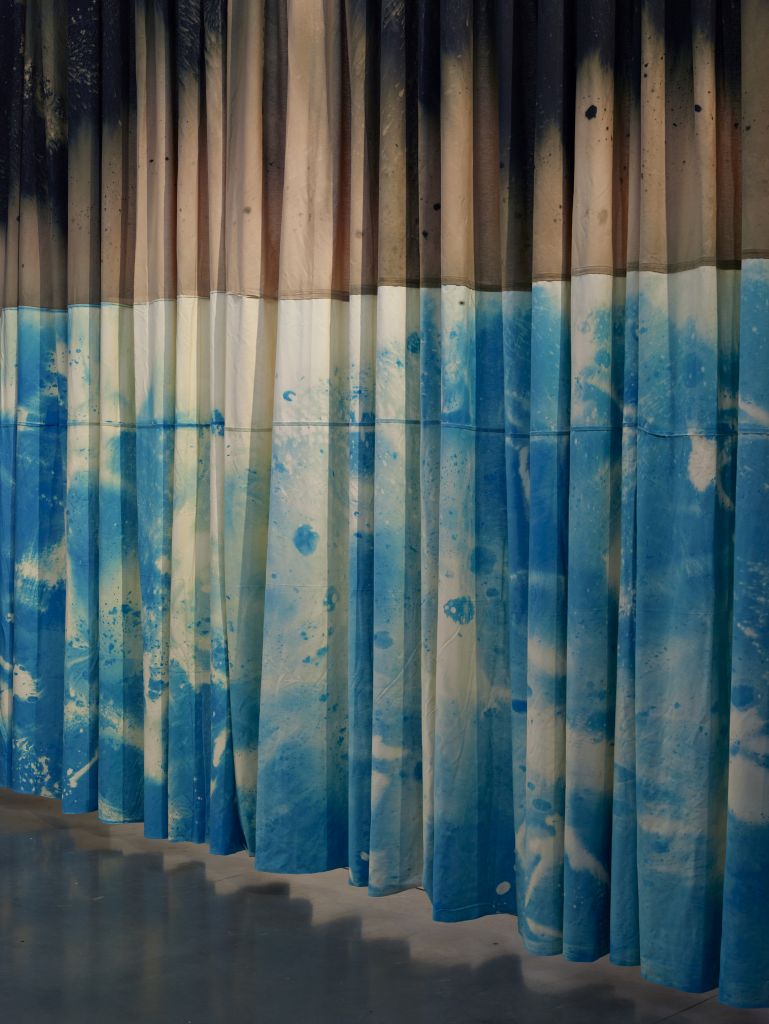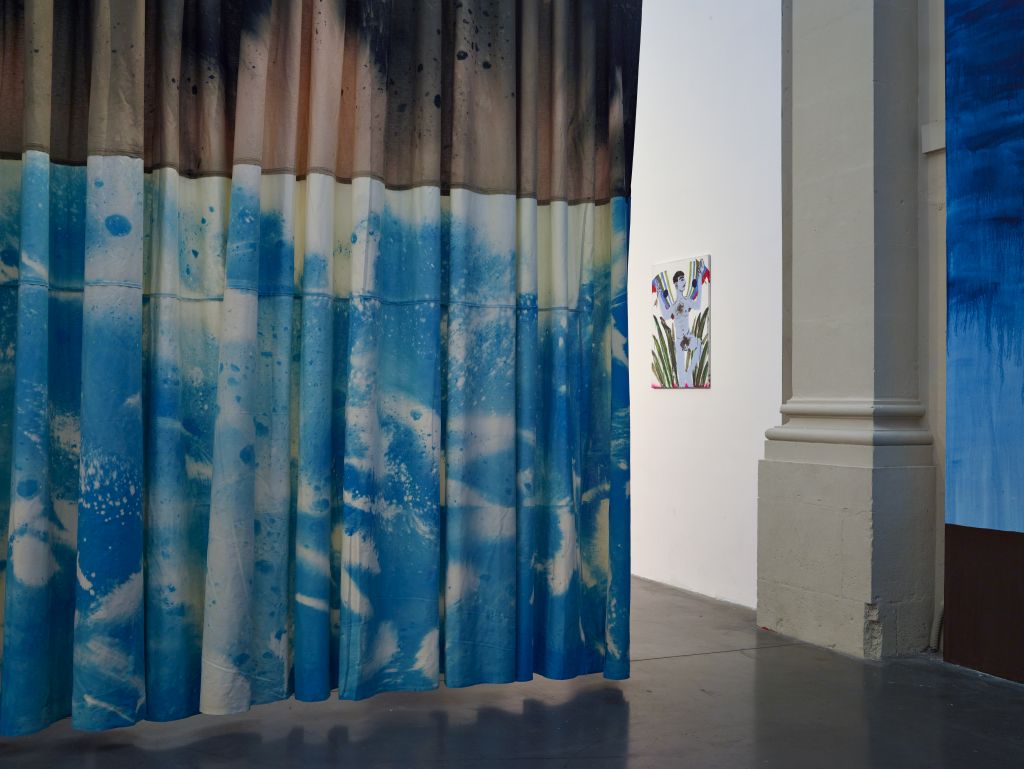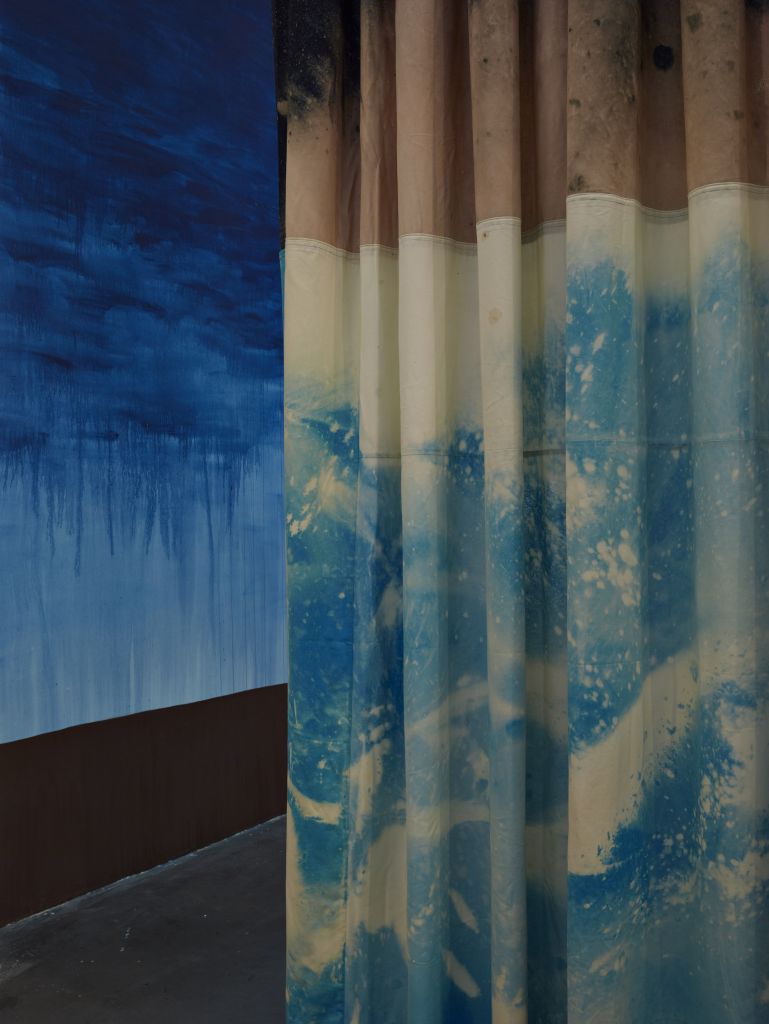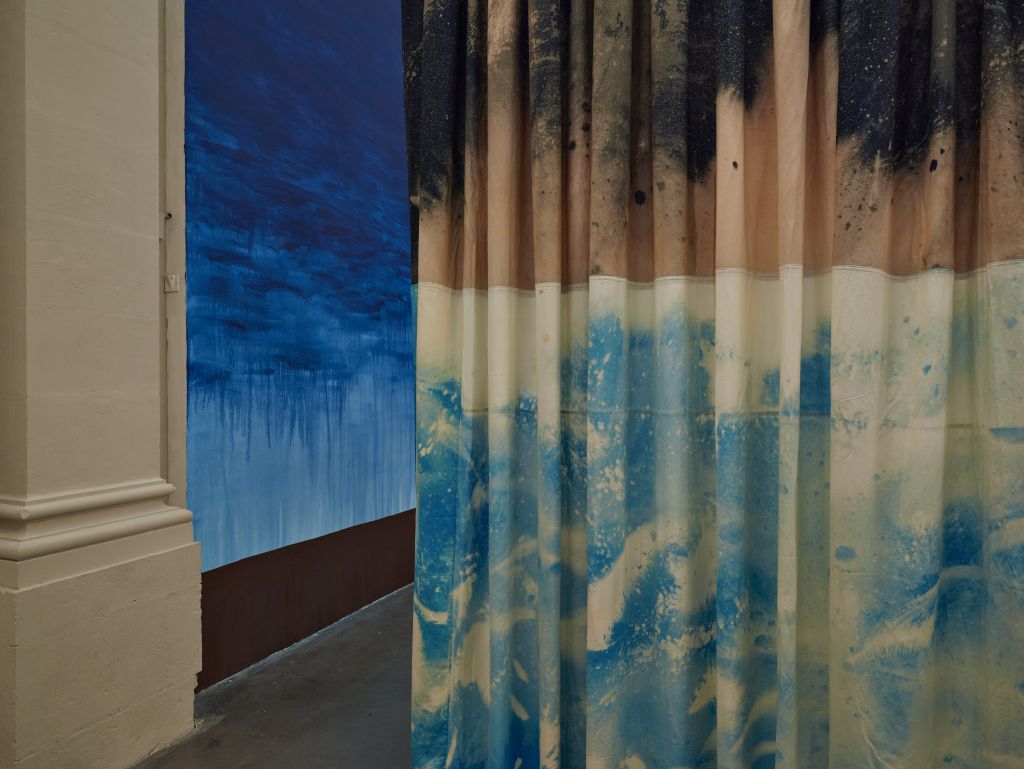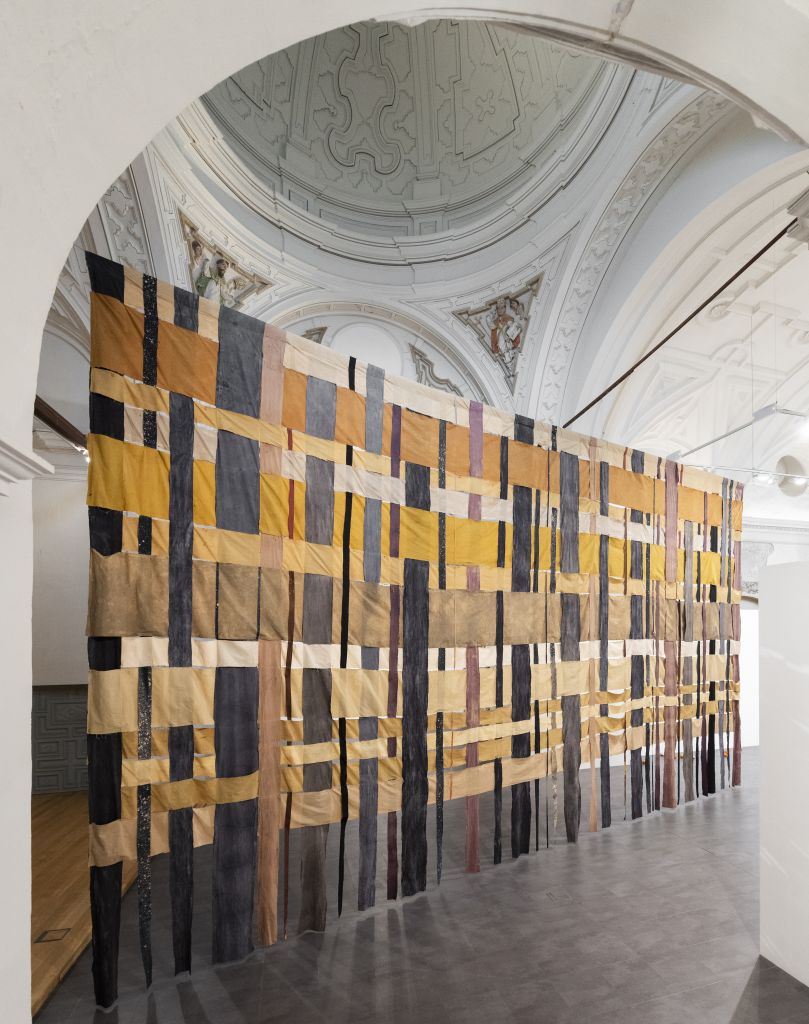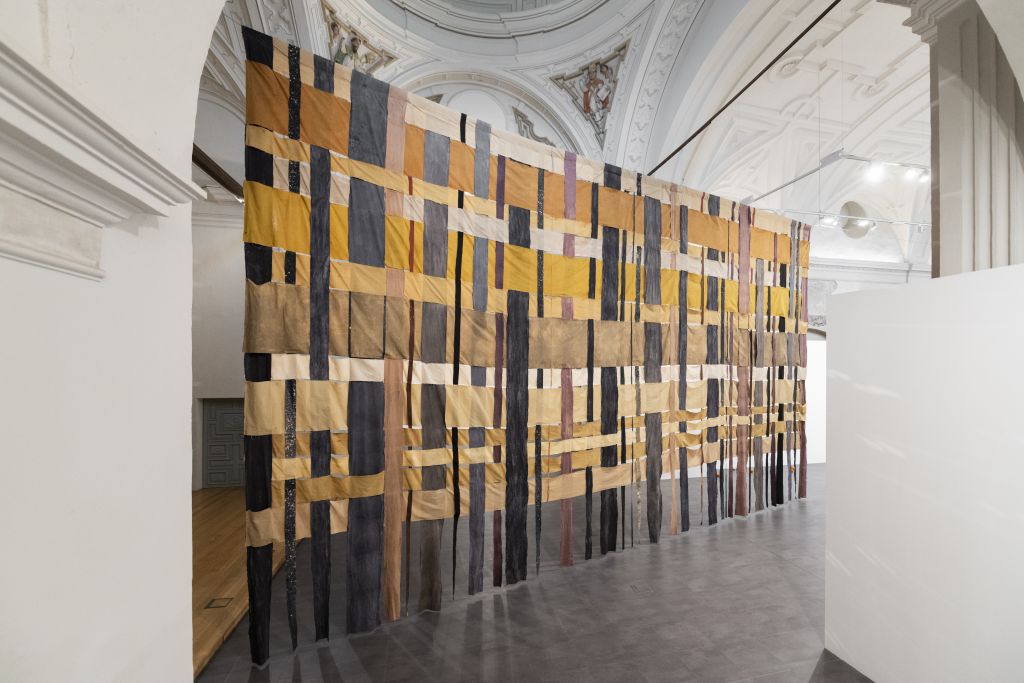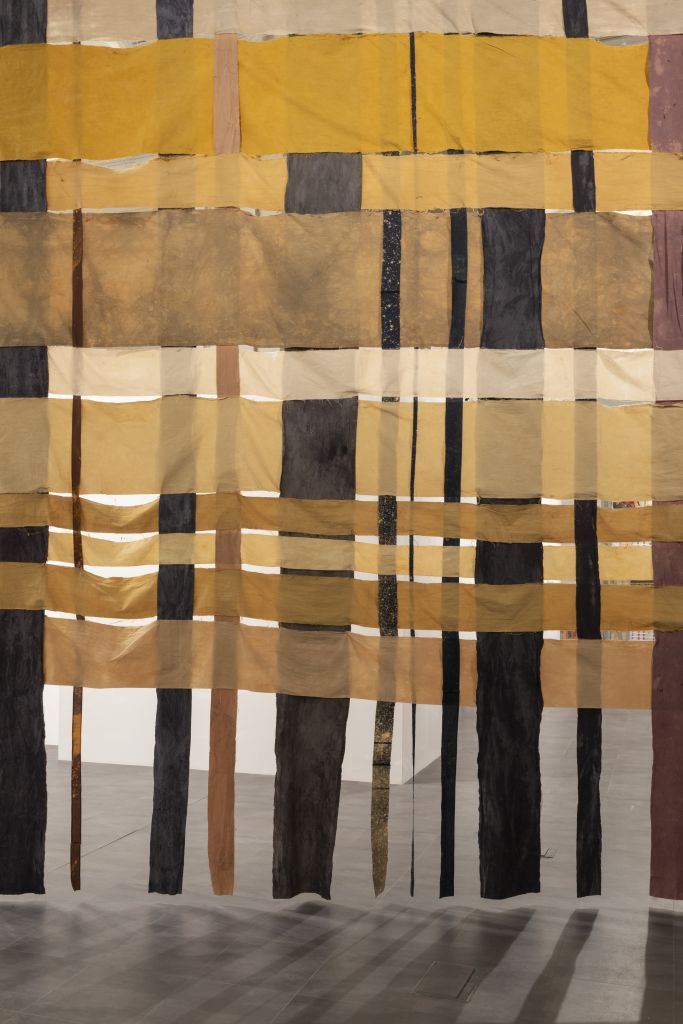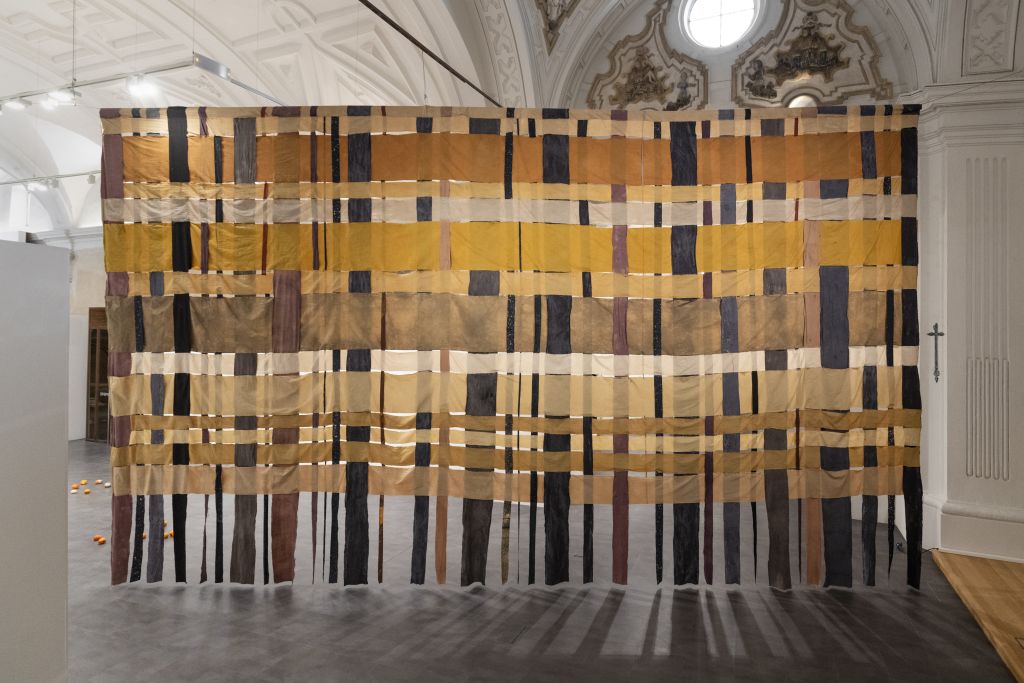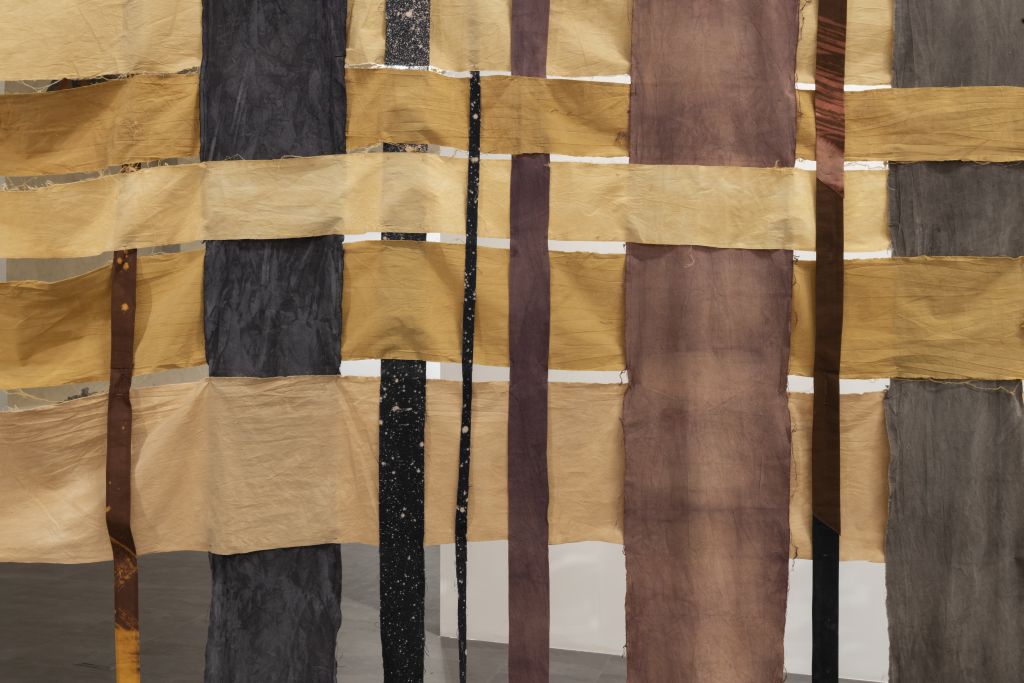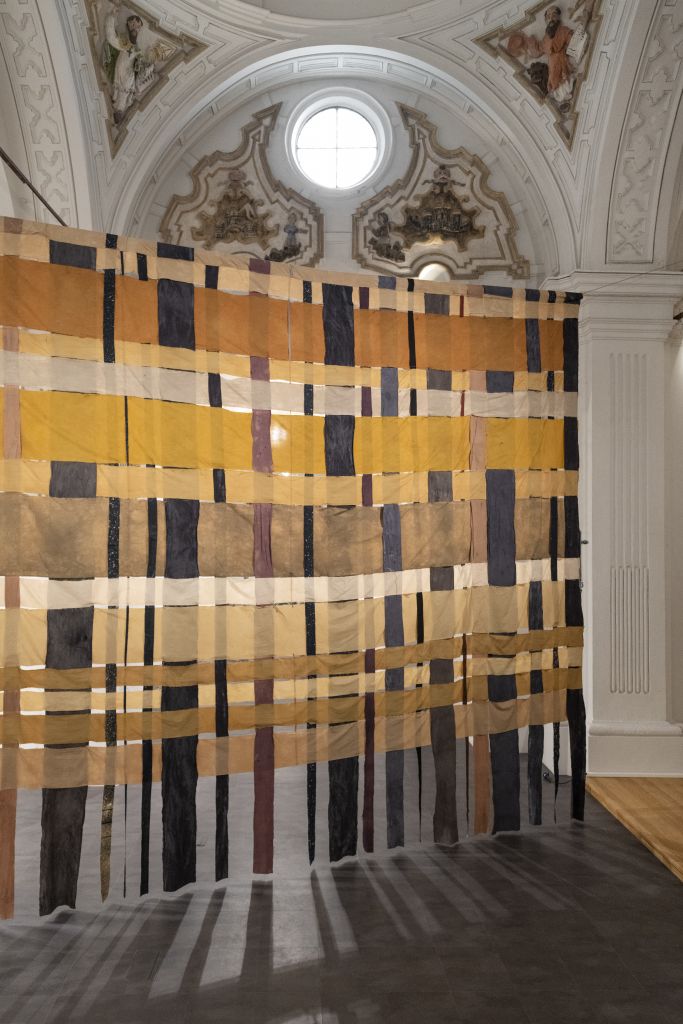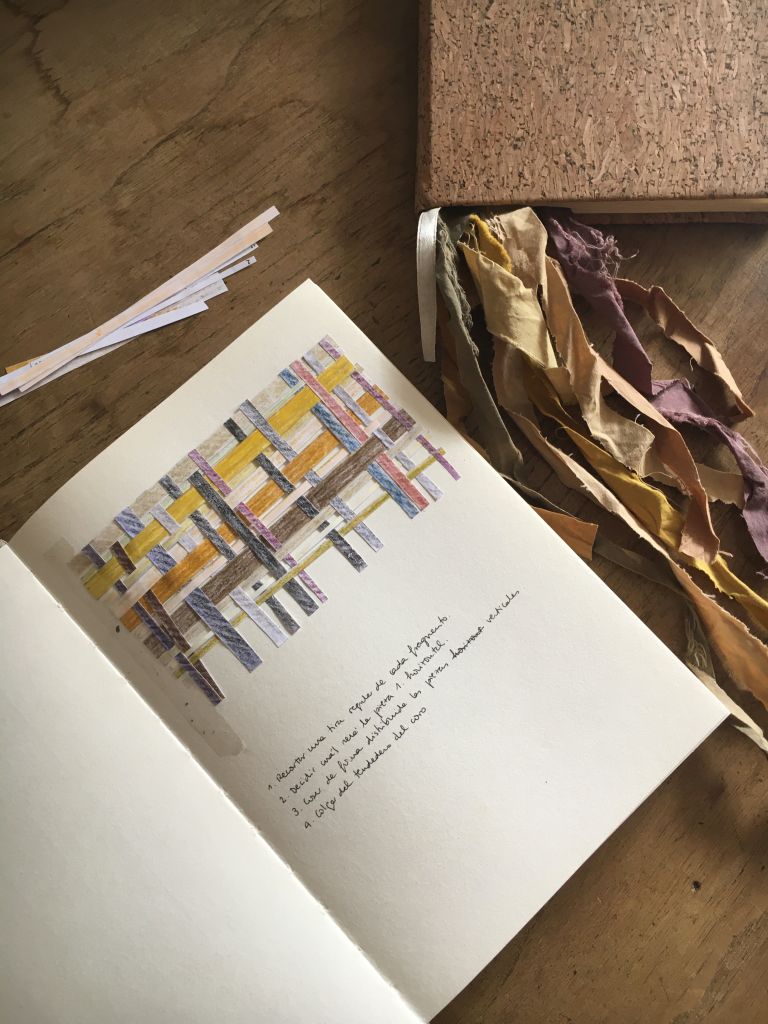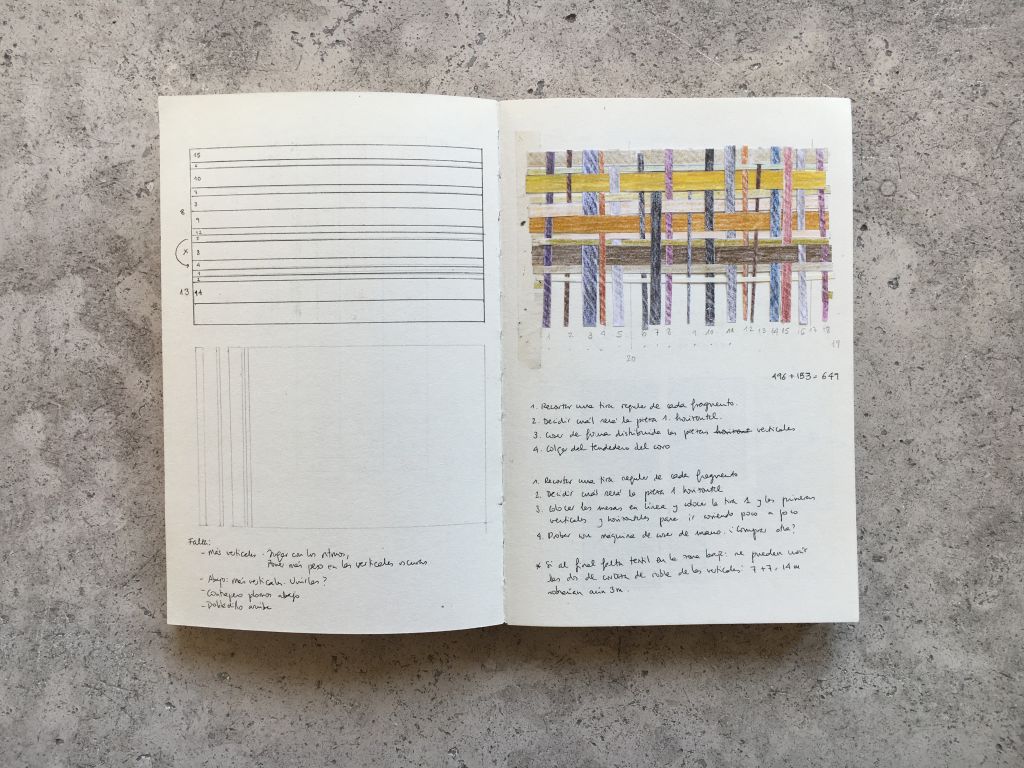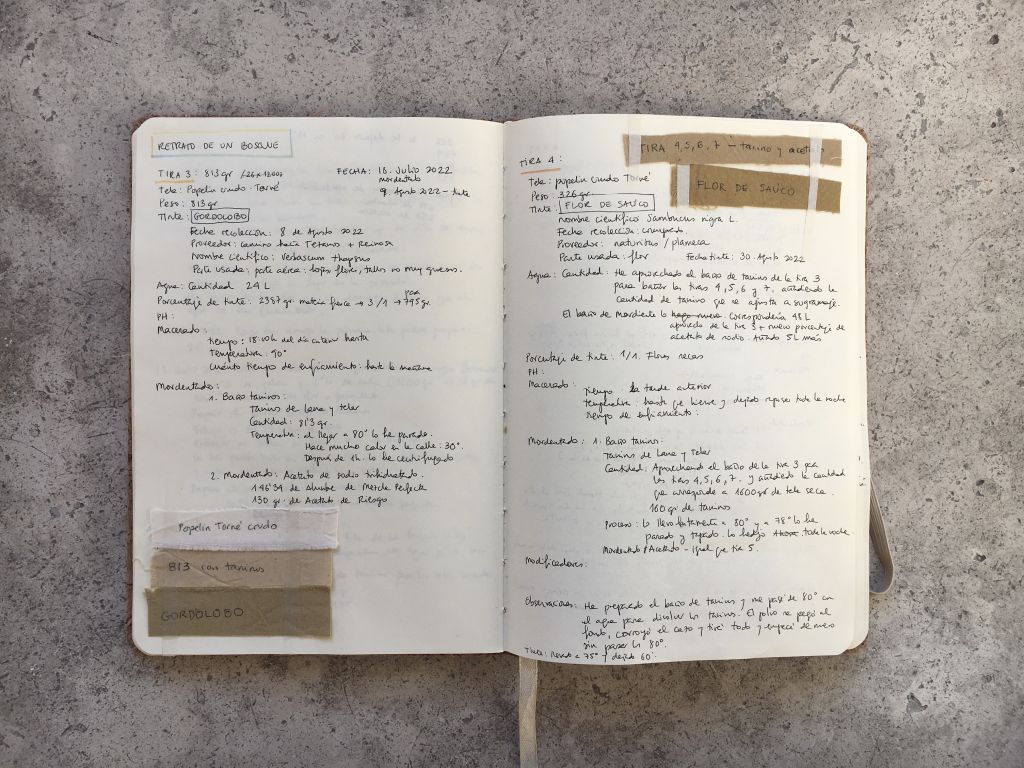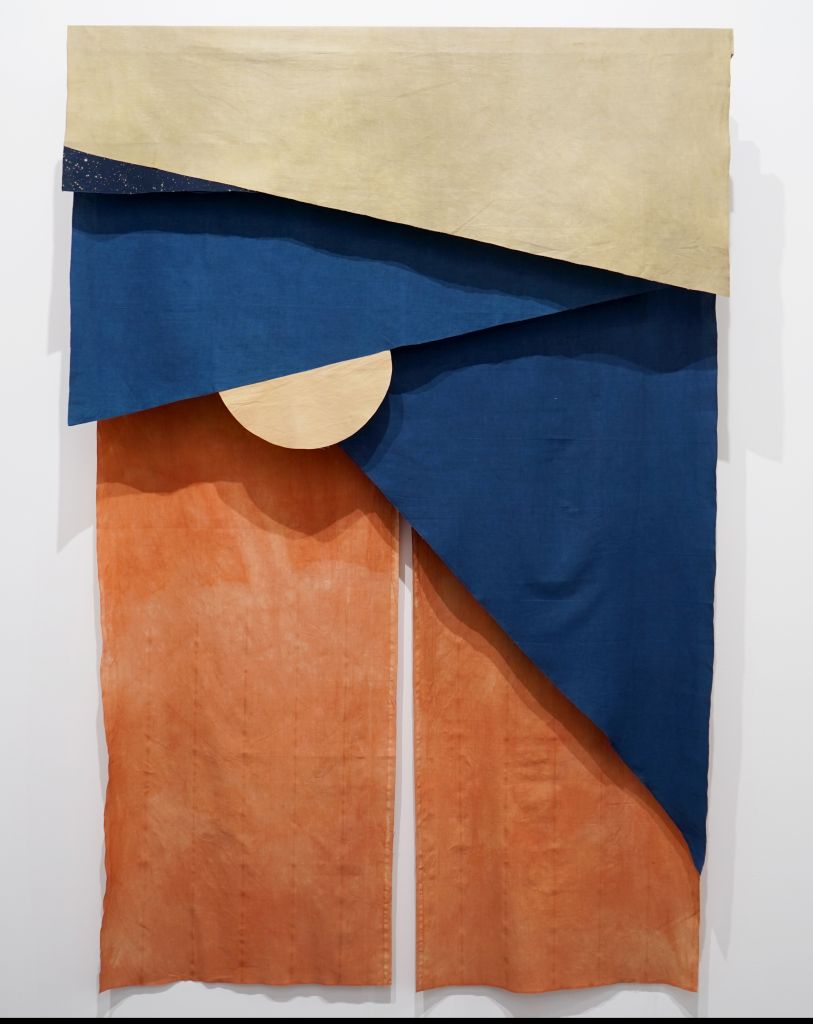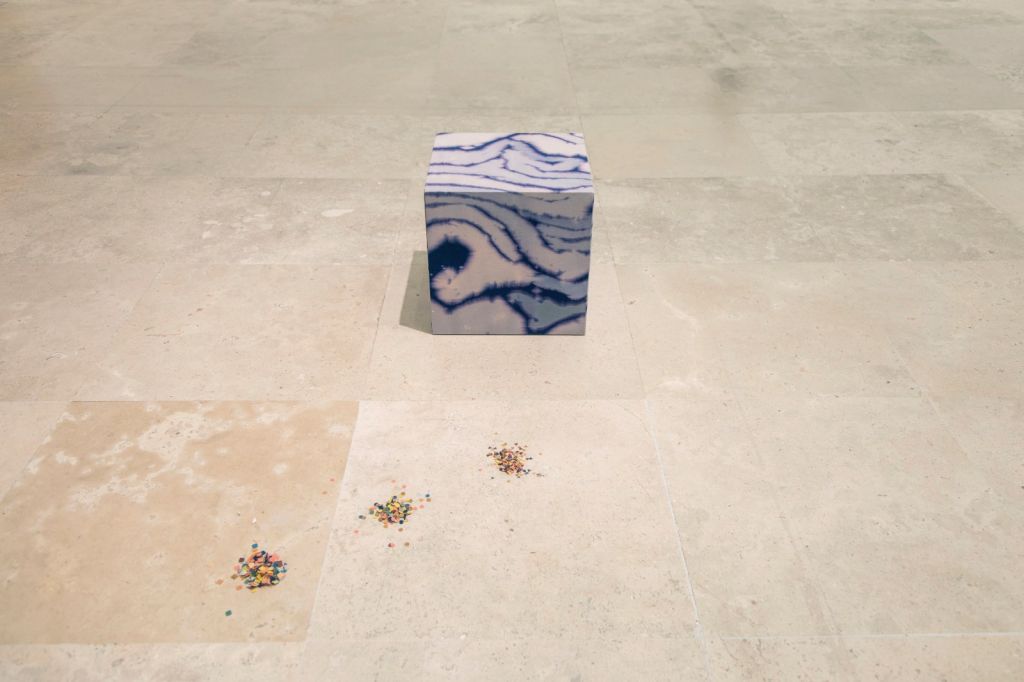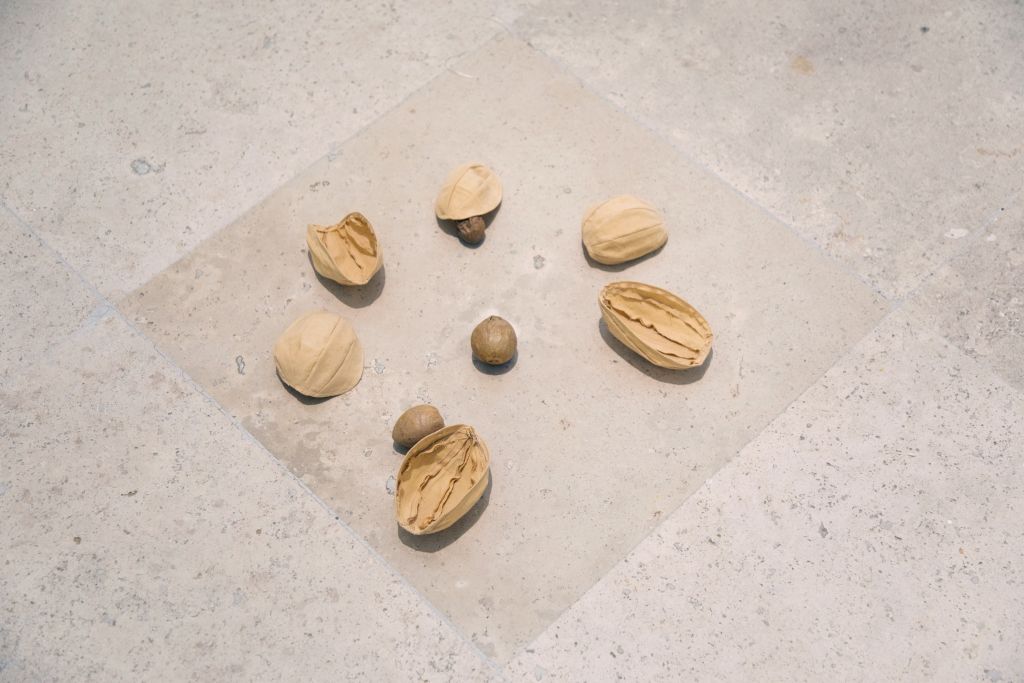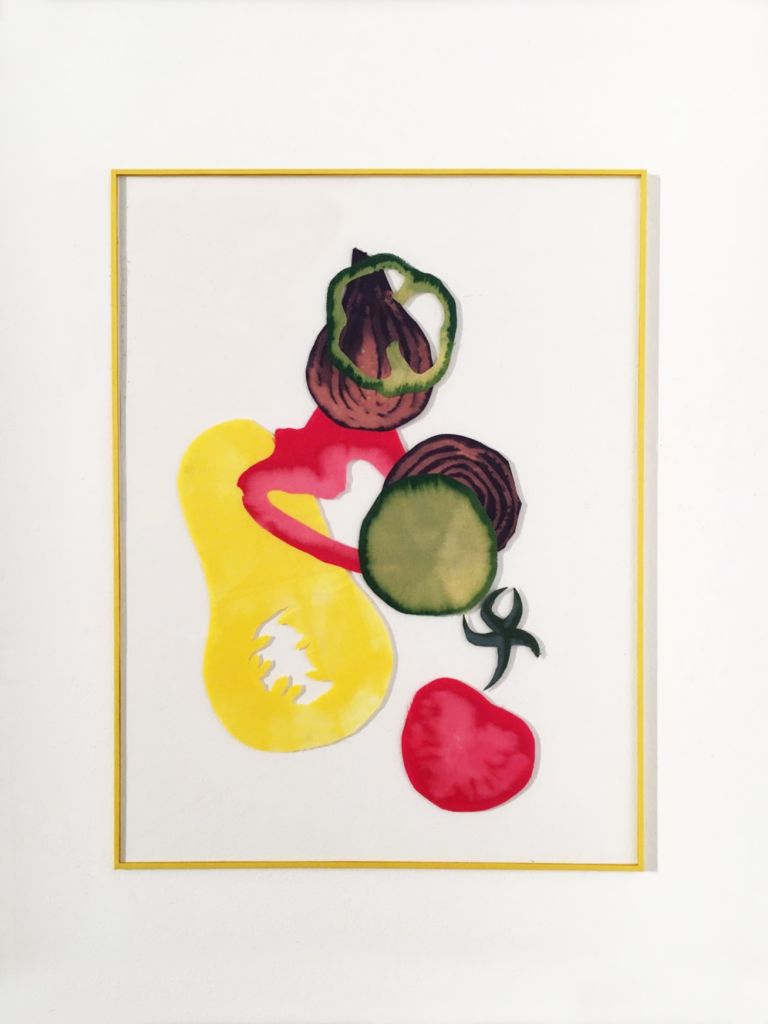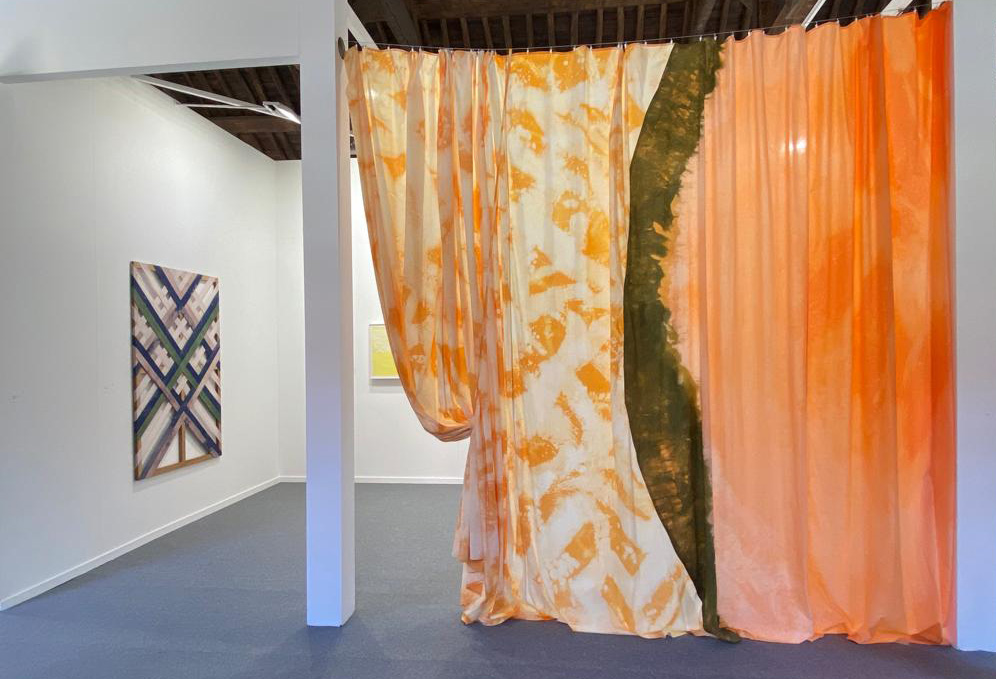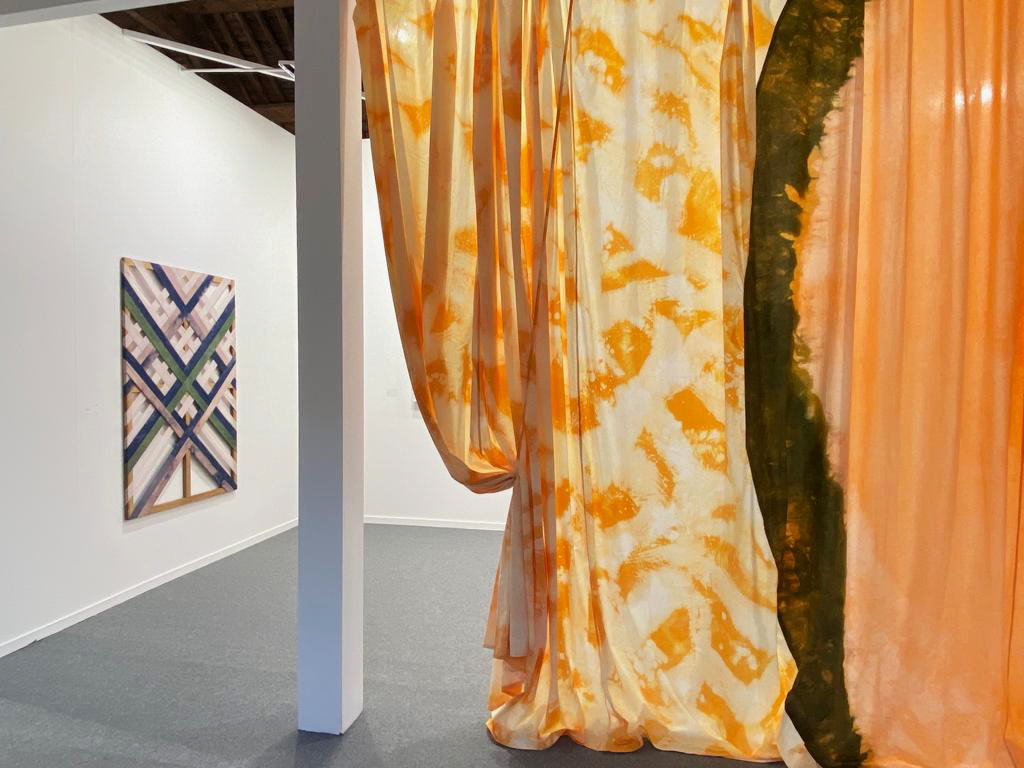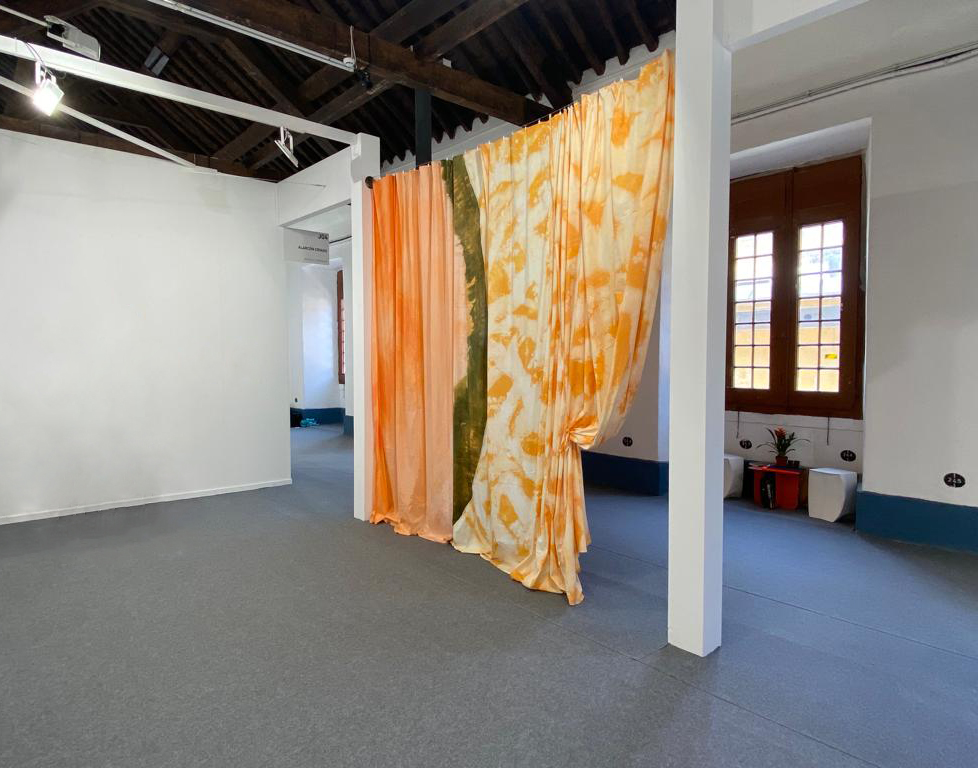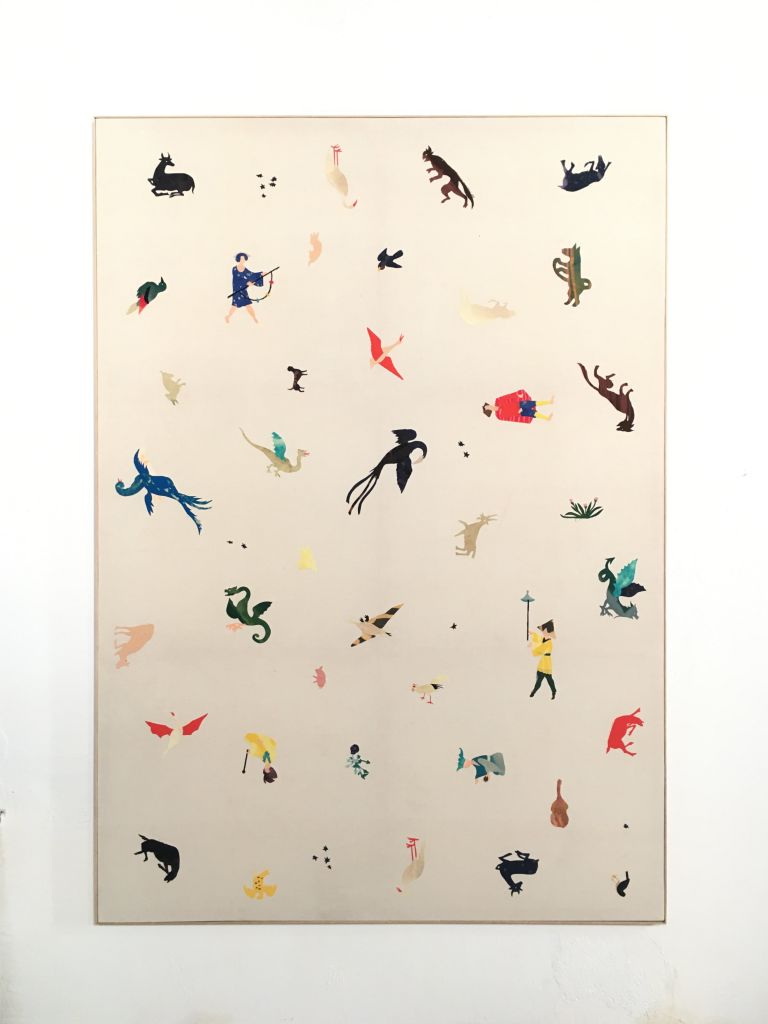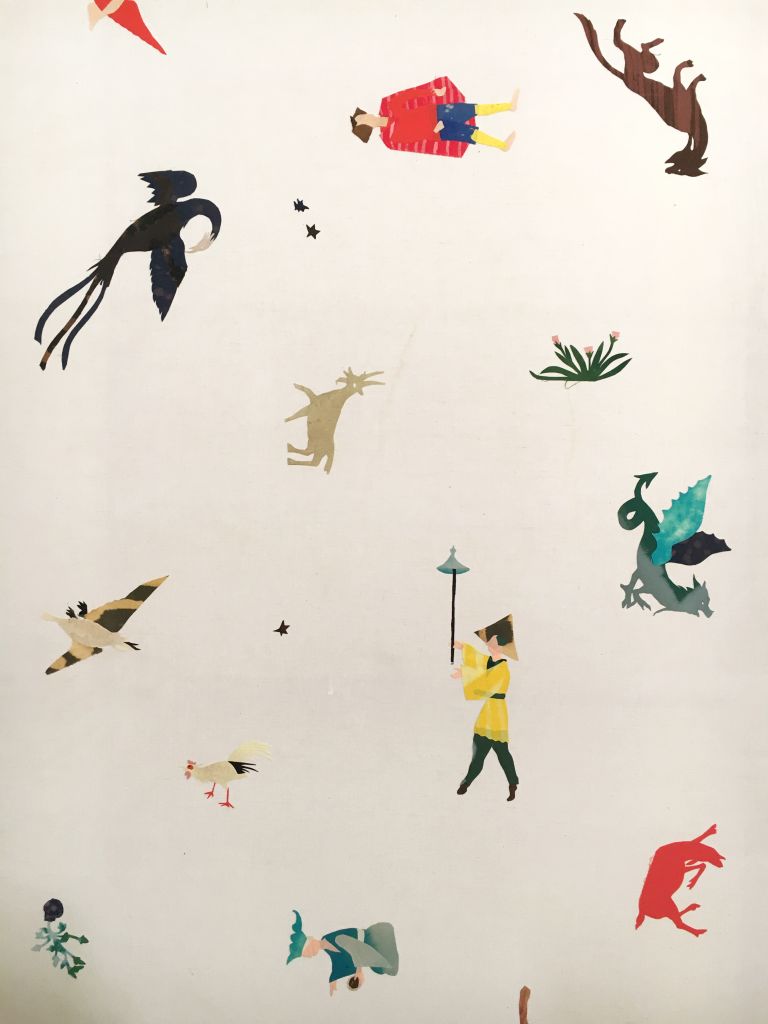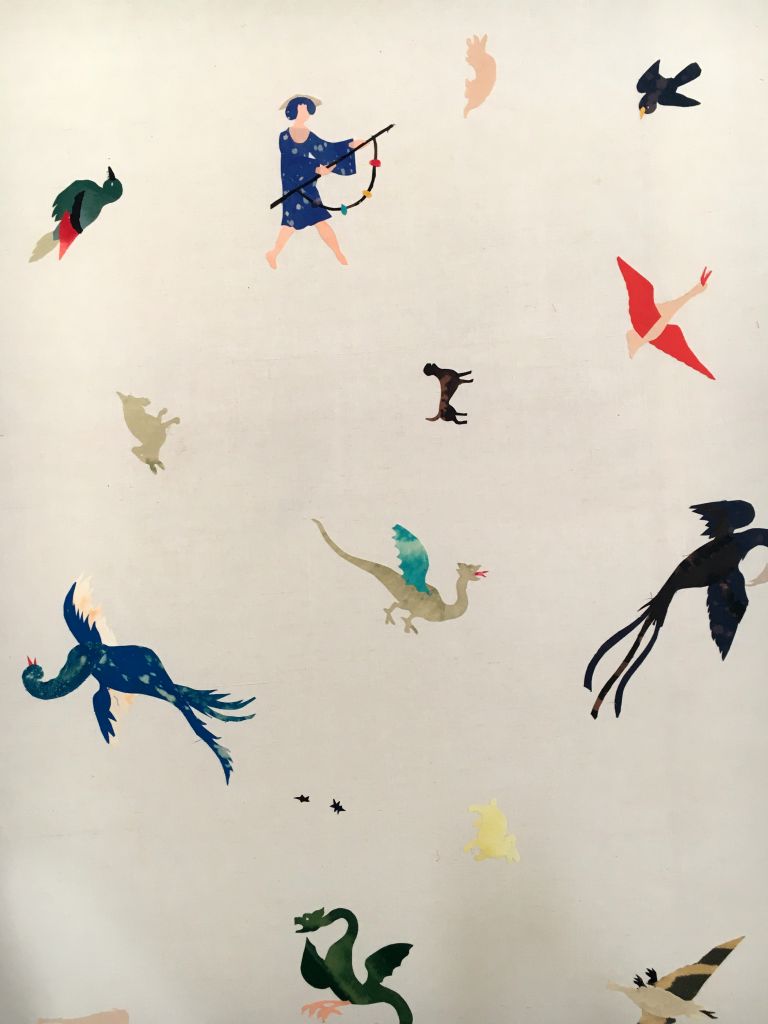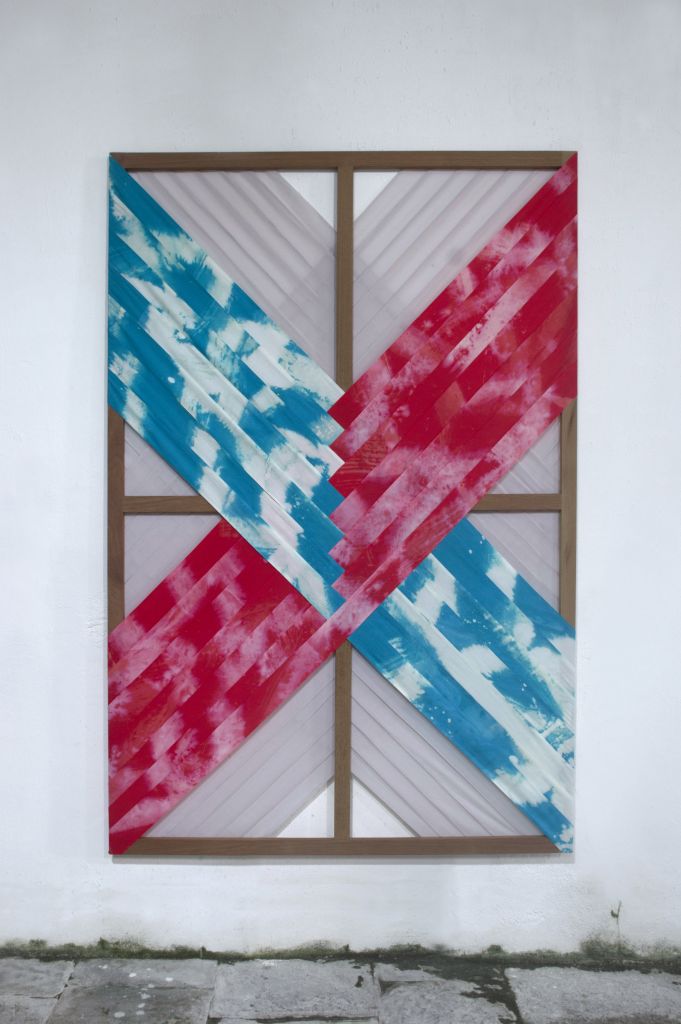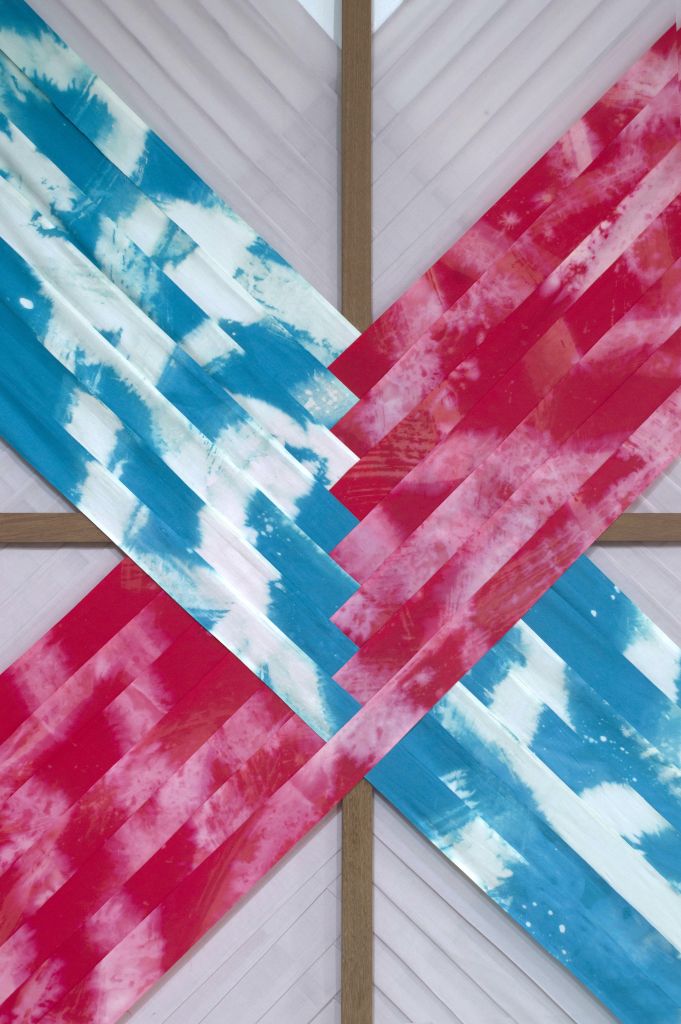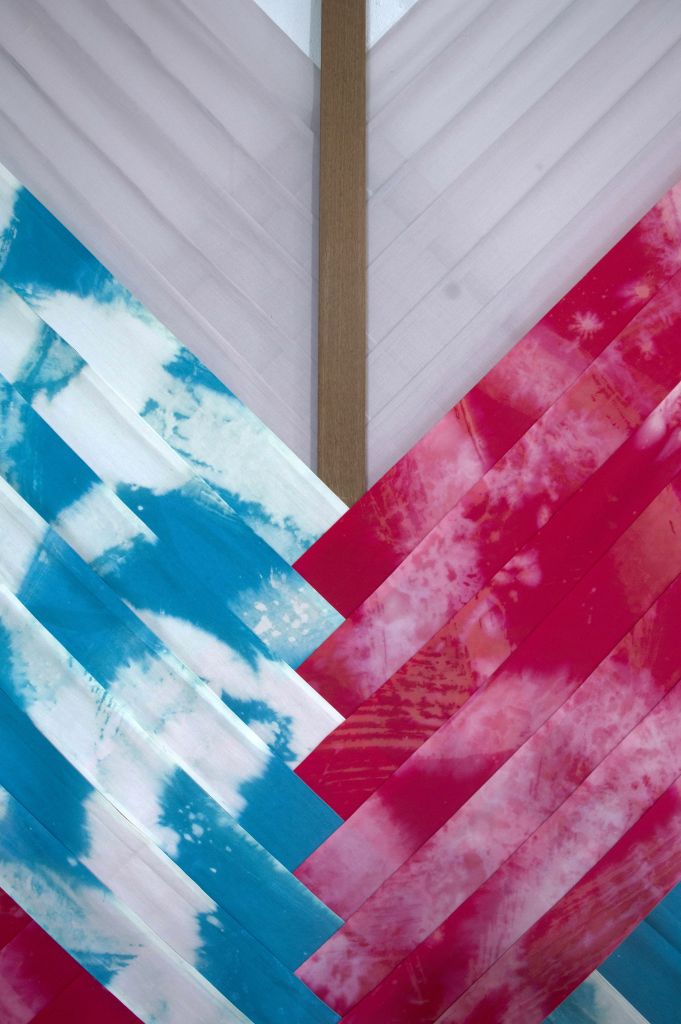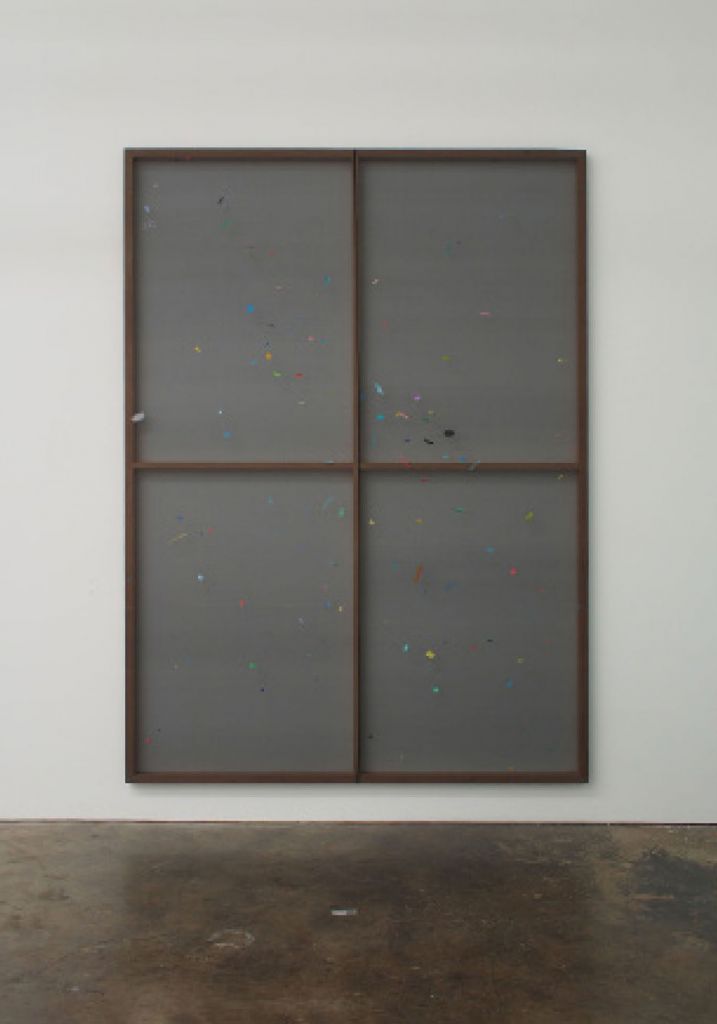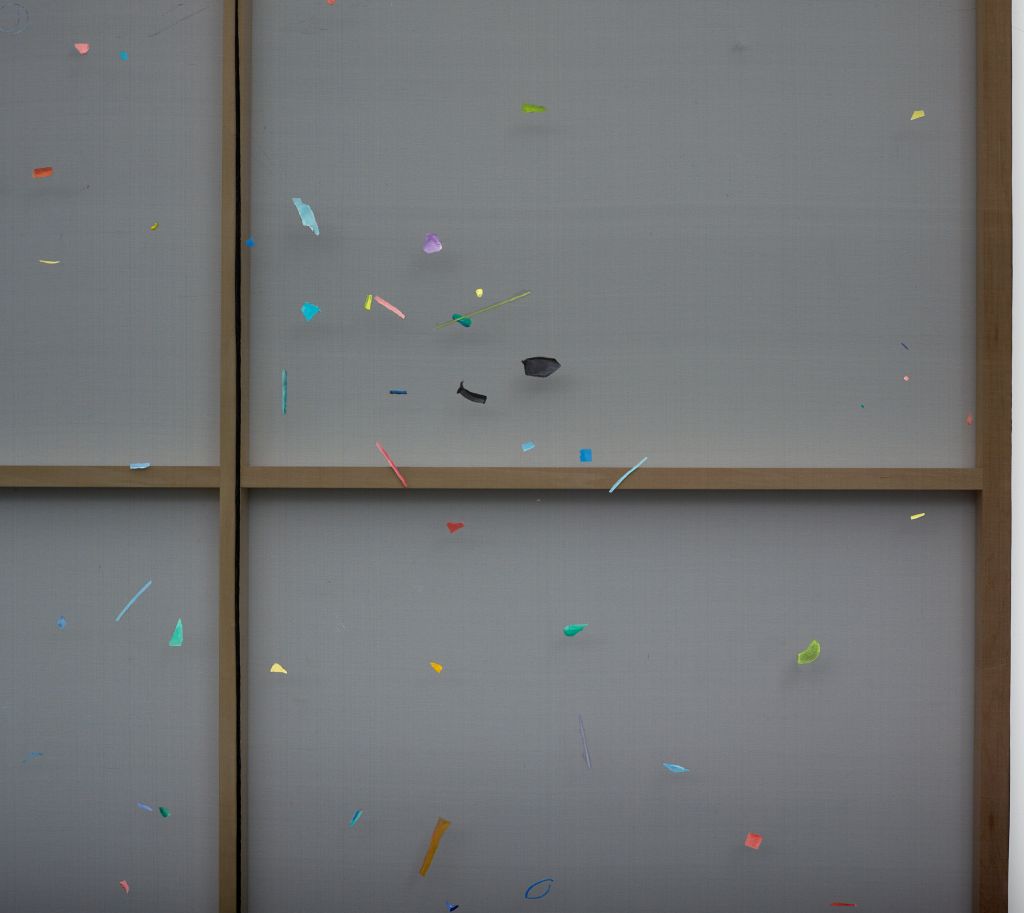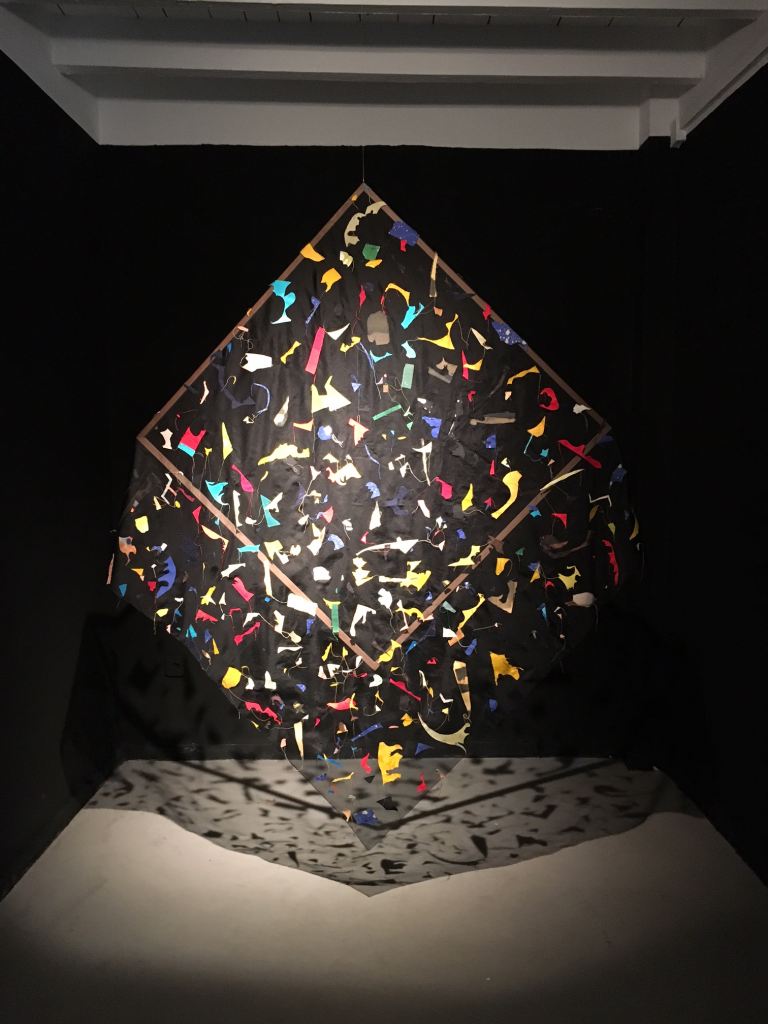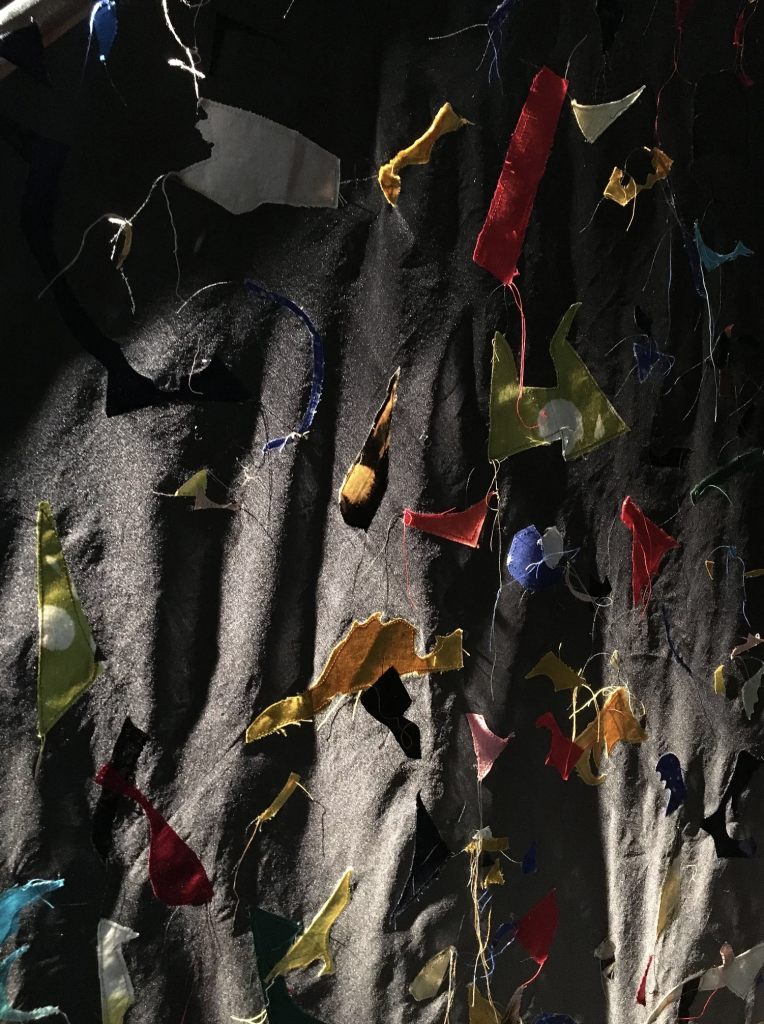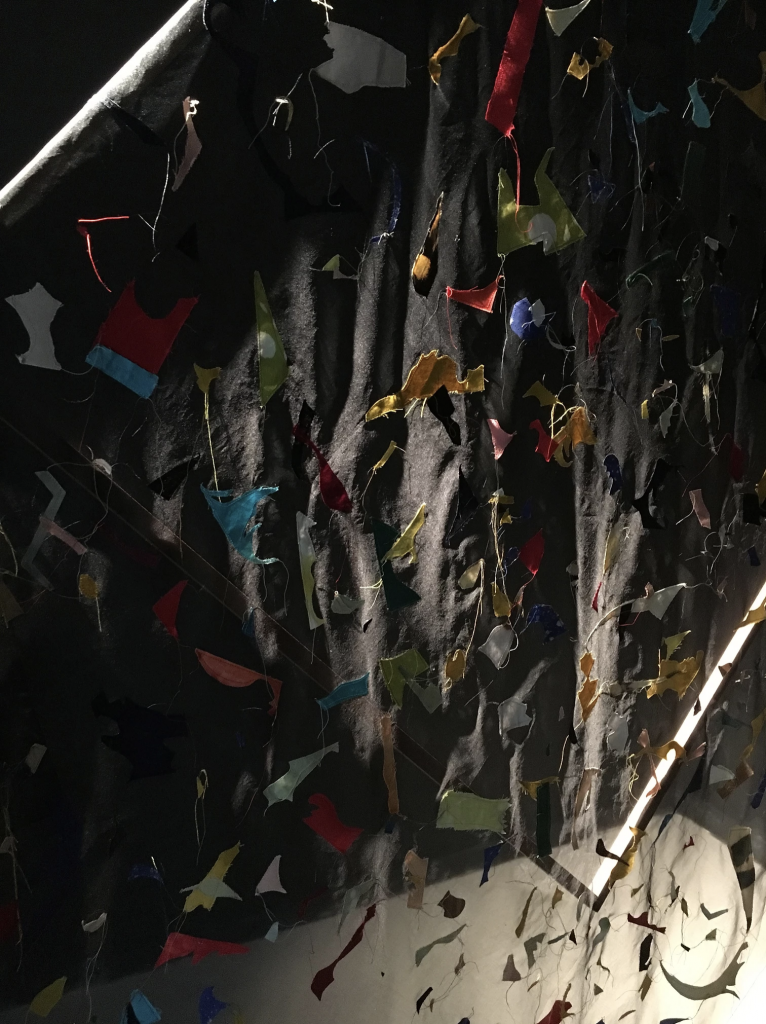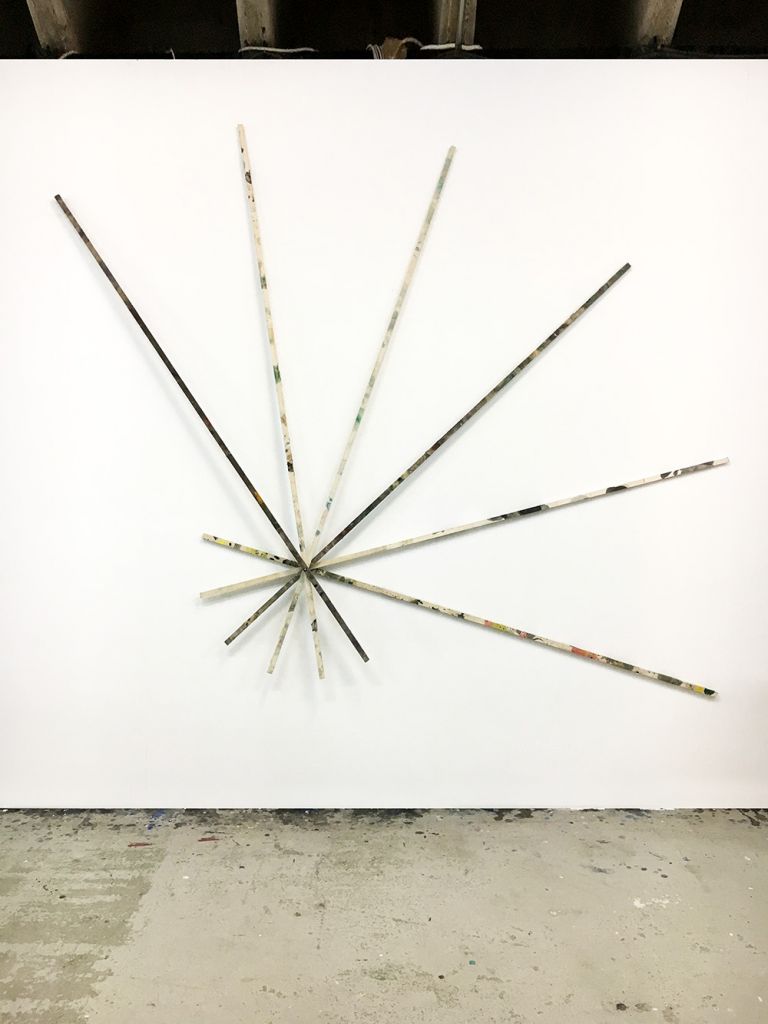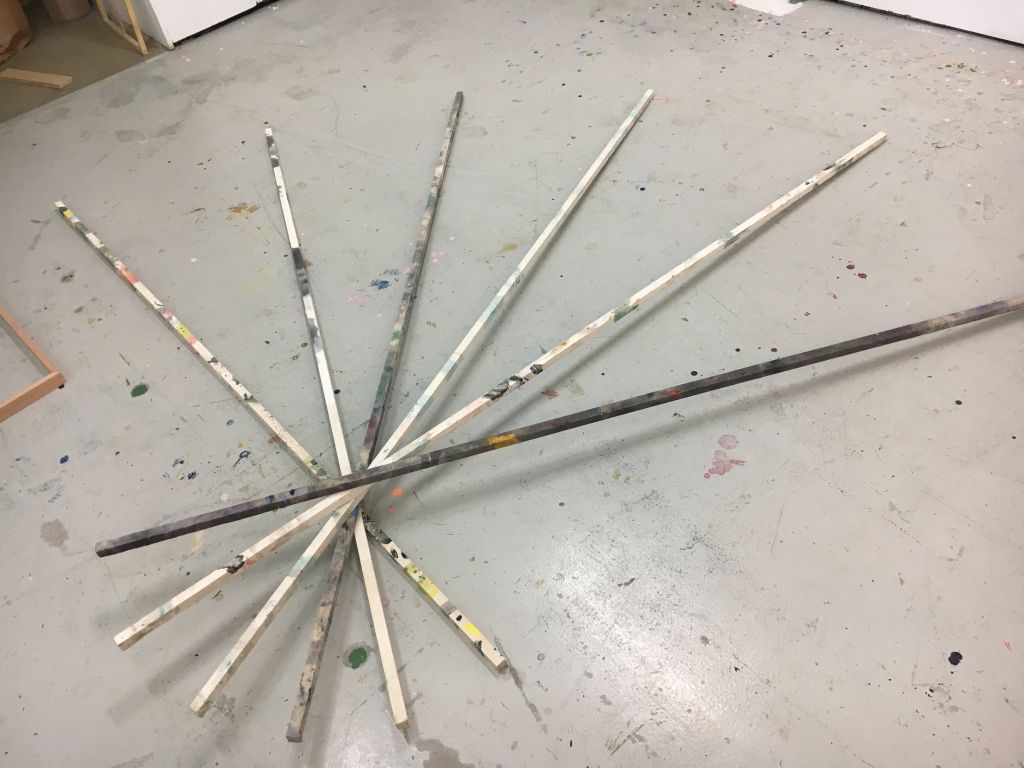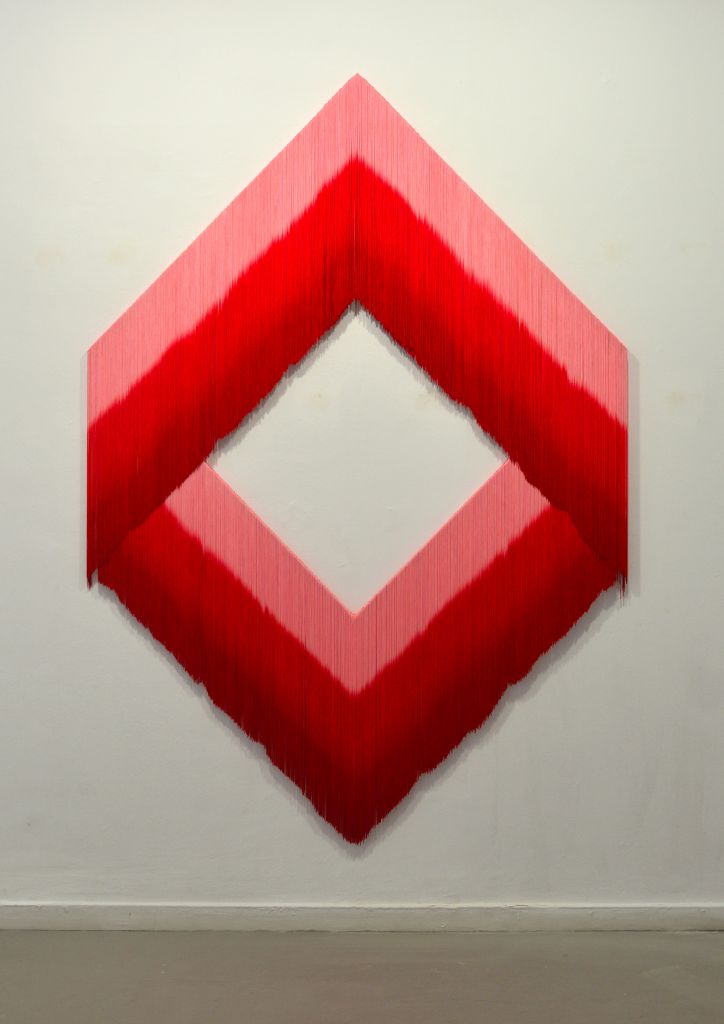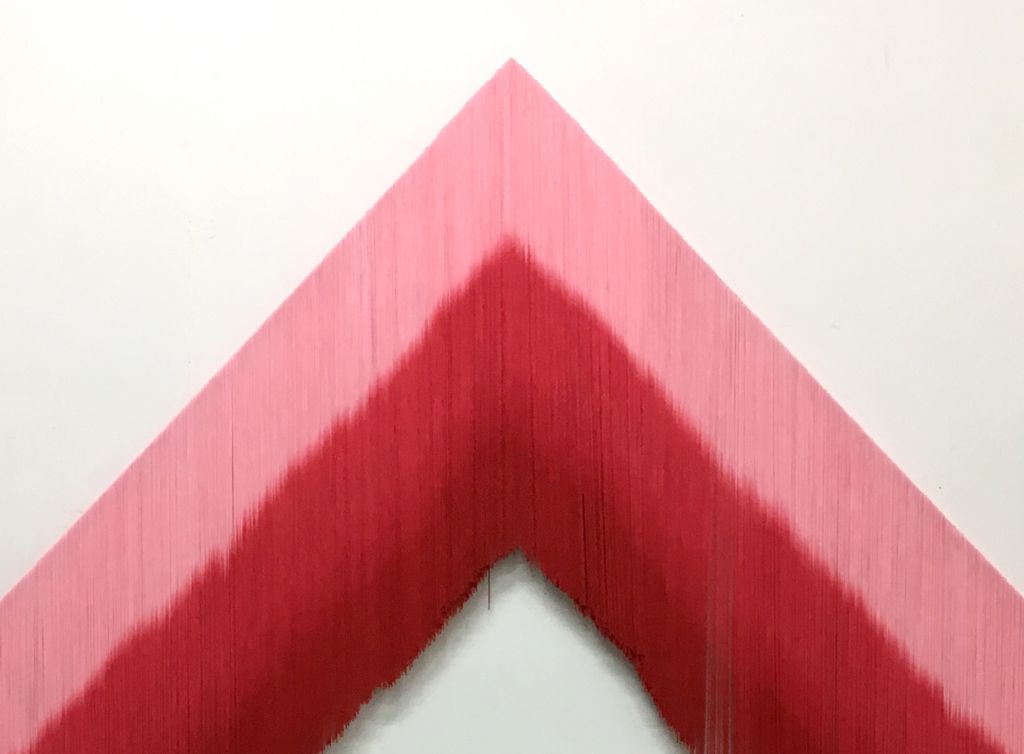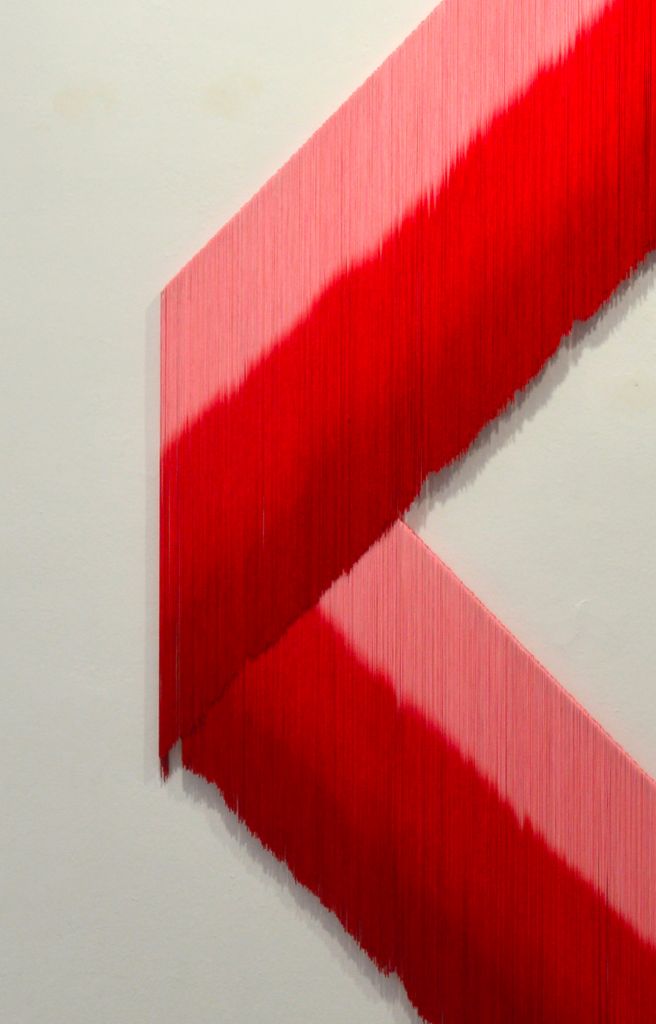BELÉN RODRÍGUEZ I SAL METÁLICA
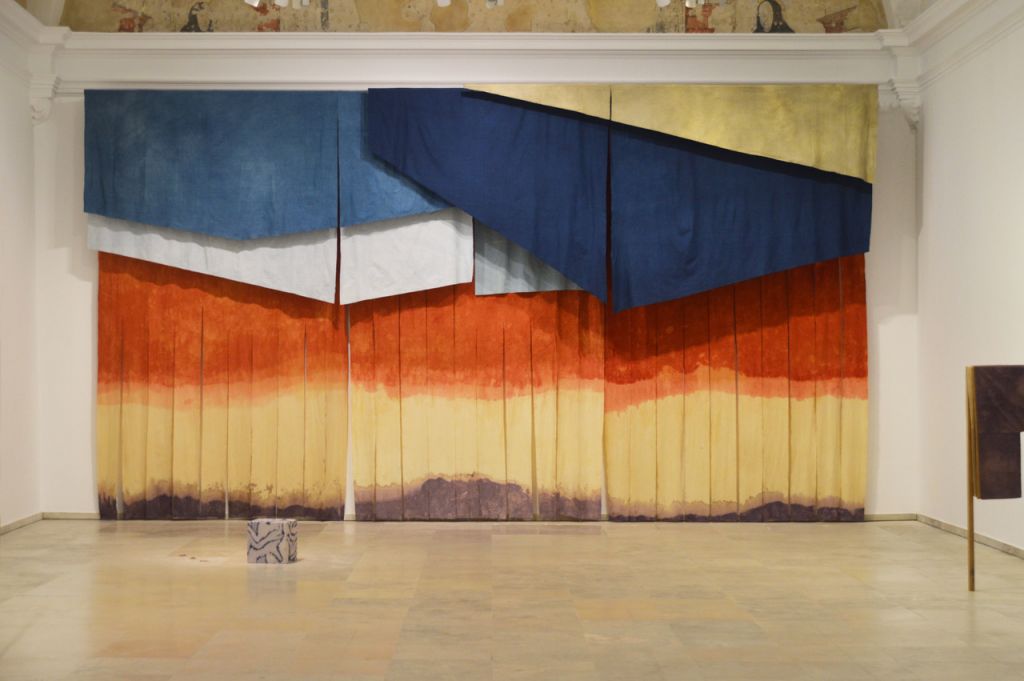
Belén Rodríguez, Sal metálica. Chapel and Room 9. Patio Herreriano, Museum of Spanish Contemporary Art, 2023. Curator Javier Hontoria.
Curatorial Text
It has become the norm in the Museo Patio Herreriano’s programme to assign the Chapel of the Counts of Fuensaldaña and the adjoining space, known as the Gil de Hontañón Room, to artists from different generations and backgrounds for projects of a specific nature, i.e. pieces conceived in relation to the qualities of the place. The one now presented by Belen Rodríguez (Valladolid, 1981), entitled “Metallic Salt”, addresses the space as an extension of the “pictorial”, a logical consequence of the evolution of her most recent work, whose core interest lies in the reformulation of the constituent elements of painting, such as those related to colour. The use of the adjective “core” is not an idle choice of word, as her work shows an inclination to observe what is structural in the languages of painting, something testified to by the repeated presence of “supports”, fundamentally stretcher frames, and other surfaces, forms or spaces susceptible of accommodating painting. “Metallic Salt” also gives rise to a wide range of new readings and narrative nuances hitherto unheard of, since, in its passage through the unique space of the chapel, gazes and bodies oscillate freely between image and matter, plane and fold, contemplation and action or the experience of the real and the expectation of the possible. In relation to the latter, it is worth noting that in the emphatic historical nature implicit in the space, fiction now slips into subtle and luminous insinuations.
Metallic salt – which is not a metaphor but a real chemical process – is the element that makes it possible for colour to be constituted as such. It is the conductor of the pigment towards a state that allows it to become perceptible to the human eye. We might say, perhaps from a somewhat lax approach, that it turns the ethereal condition of light into potential chromatic matter. The pieces we see in Room 9 are composed of fabrics that have an ambivalent relationship with their supports, while in their different dialogues, or in the different ways in which fabric and support relate to each other, the transit is formalised. Belén Rodríguez makes no secret of the sources and stimuli that inspire her interest, namely a head of red cabbage, autumn in the forests of Cantabria, the skin of an avocado, the cold texture of marble… Based on a meticulous conceptual process, the perception of the different tonalities takes shape. On the one hand, she echoes the internal rhythms of nature, and on the other, she notes that colour becomes visible only from subjective impressions that can hardly be ascribed to regulatory standards. In any case, her exhaustive analysis comes to a firm conclusion: colour enjoys a vigorous and inalienable autonomy.
The concept of the fold, which Baroque aesthetics adopted as its own, is a recurrent presence. The dazzling movement of lines and forms characteristic of the Baroque is analogous to the way in which colour inhabits nature. Like a bird that accidentally flies into a room and which you guide back out again with your eyes, colour is a frenetic stimulus that is carried along by the light. Belén Rodríguez resorts to a strategy in the dyeing of fabrics that involves letting nature do its thing and entrusting everything to organic implementation. Hers is more the position of an observer of the processes, as she seems to pay attention to the way in which the fabrics are activated by the action of nature. Her work in the studio drifts towards a reflexive approach to the processes she has witnessed.
*
The piece that Belén Rodríguez has created for the museum’s Chapel responds quite naturally to the challenge posed by the scale of the space, questioning it from the bottom and from the form, that is, from the assumption of the proportion of the place and from the narrative character that defines it. A large surface area of almost one hundred square metres takes up the entire space. It is perceived as a territory, a landscape through which we walk, dressed in the attire designed by the artist. The surface of the canvas evokes a stony, marble-like material, while the whole confirms the scenographic nature that many of her earlier pieces already hinted at. It should be pointed out that the evolution of Belén Rodríguez’s work towards the scenographic has seen some of its most significant peaks at the Patio Herreriano, since during her time in Room 0 and in the recent collective exhibition “Painting. Ongoing Renovation”, we saw growing spatial yearnings, which are materialised here in an unprecedented dimension. What this piece introduces is a habitable nature, an induction into experience, a painting that rather than being looked at, is lived, and the place that is transformed, ductile and dynamic, always different after we have passed through it. We tend to give a contemplative slant to everything we understand as iconic, and this large marble surface, which has the magnetic quality of all icons, provides an experience extended in time, something that becomes a flowing perceptive torrent.
There are, therefore, many reasons why this exhibition devoted to Belén Rodríguez is important to us, and we would like to thank all the people who have been involved in its production. There are plenty of them, given the complexity of the project. It is a process that has been delocalised between Cantabria and Valladolid and is now seeing its joyful resolution in our galleries.
Javier Hontoria
Sal metálica. Edition Patio Herreriano. Museo de arte contemporáneo español, Valladolid, 2023
"Metallic salt – which is not a metaphor but a real chemical process – is the element that makes it possible for colour to be constituted as such. It is the conductor of the pigment towards a state that allows it to become perceptible to the human eye. We might say, perhaps from a somewhat lax approach, that it turns the ethereal condition of light into potential chromatic matter." Javier Hontoria
BELÉN RODRÍGUEZ
Turco y antiguo
2023
Cotton cloth filled with recycled cork dust.
1200 x 600 x 35 cm
Chapel. Patio Herreriano. Museum of Spanish Contemporary Art, Valladolid, 2023
…The piece that Belén Rodríguez has created for the museum’s Chapel responds quite naturally to the challenge posed by the scale of the space, questioning it from the bottom and from the form, that is, from the assumption of the proportion of the place and from the narrative character that defines it. A large surface area of almost one hundred square metres takes up the entire space. It is perceived as a territory, a landscape through which we walk, dressed in the attire designed by the artist. The surface of the canvas evokes a stony, marble-like material, while the whole confirms the scenographic nature that many of her earlier pieces already hinted at. It should be pointed out that the evolution of Belén Rodríguez’s work towards the scenographic has seen some of its most significant peaks at the Patio Herreriano, since during her time in Room 0 and in the recent collective exhibition “Painting. Ongoing Renovation”, we saw growing spatial yearnings, which are materialised here in an unprecedented dimension. What this piece introduces is a habitable nature, an induction into experience, a painting that rather than being looked at, is lived, and the place that is transformed, ductile and dynamic, always different after we have passed through it. We tend to give a contemplative slant to everything we understand as iconic, and this large marble surface, which has the magnetic quality of all icons, provides an experience extended in time, something that becomes a flowing perceptive torrent…
Javier Hontoria
BELÉN RODRÍGUEZ
Wombo Lombo
2023
Three teak wood frames. Ten cotton tunics dyed with natural dye.
230 x 200 x 400 cm
BELÉN RODRÍGUEZ
Sube la montaña, baja la montaña
2023
Bamboo pole and hanging cloth.
240 x 800 cm , 7 cm diameter
BELÉN RODRÍGUEZ
El adjetivo estaba en pasado (mangas)
2023
Teak wood support and fabrics dyed with natural dyes.
145 x 90 x 10 cm
BELÉN RODRÍGUEZ
Desde una madriguera (Celosía espigada)
2023
Teak wood support and fabrics dyed with natural dyes.
250 x 170 cm
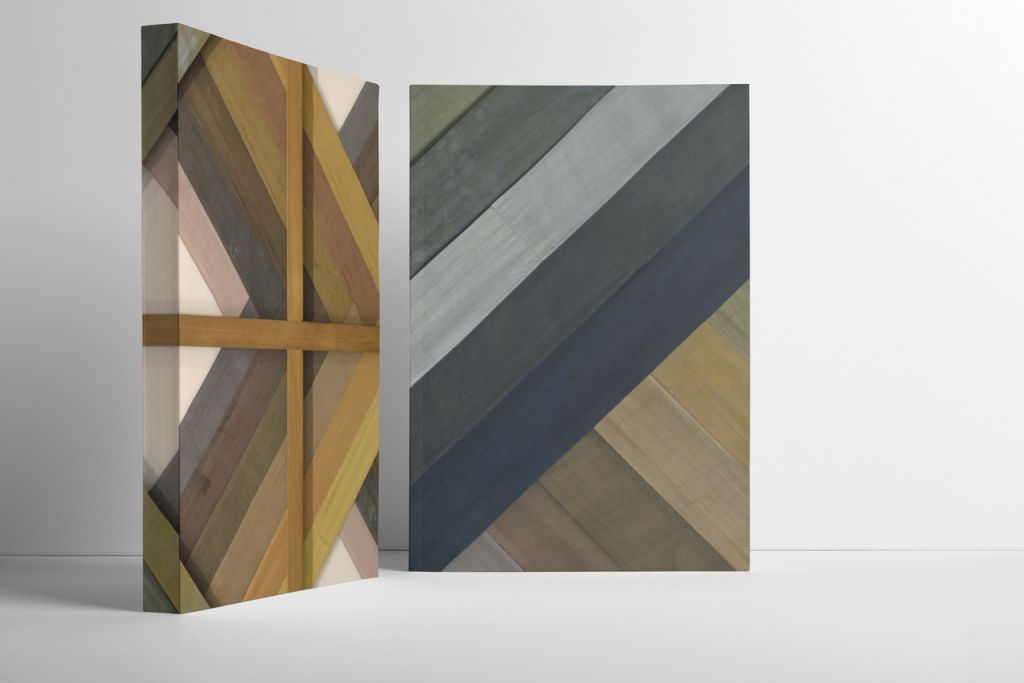
An Art Pulsing With the Life of Earth. On the work of Belén Rodríguez, Chus Martínez.
Departures
The work of Belen Rodriguez embodies a search for a new practice of art. Her work is full of the respect and the owe for the centuries that made painting and sculpture a major artistic language able to speak the subjects of the times, able to depict the tensions of the powers that commissioned the works. Her work also embodies the anxieties of those languages becoming Modern, seeking for new horizons of meaning, searching for the depths promised by mystic and geometrical eternities. She understands the nervousness that transfixed the periods painting and sculpture underwent after the Modern, after the celebrations of its own being and presence. Again, the two languages left alone with society, with questions that surpassed form and composition searching for a reason to be, searching for the meaning of their own existence. Her work knows about it all, about every past period in history and about every glory and misery that these two genres experienced. She knows about their relationship with power, with gender exclusion, their relation with geopolitical hegemonic values and cannons….Knowing it all, feeling how also artistic practices can absorb and embody the bad practices of Western cultures, their blindness to diversity, to vernacular and indigenous ways of being and doing is what motivates her work. Far from resenting it, her work senses all these multiple pains anew. There is an enormous compassion in her way of doing. She acts as if Western painting and sculpture had a major accident and need, now, a long rehabilitation that she is able to provide. In her approach to the genres she acts like a healer, like a speech therapist, an orthopedist, a coacher… she is orienting all her efforts to re-direct the most central artistic languages of our pasts towards new futures. It takes a great effort to do so. The conversation starts understanding the basics: the structures that hold a piece, the wood, the metal; with the cloth stretched on the painting frames. Understanding these elements anew gives them all, —the artist and the genres— an opportunity to humble, to face substances, questions and communities never taken into before.
Boldness
It is bold to take the task upon herself to accompany art in its discovery of space —as in natural space— and tradition —as in vernacular traditions. It is an exercise that helps the artist to learn together with the language to say field, to say tree, to say sky, to say community. The process of doing this is not an easy one since in losing certain formal and material traits painting and sculpture may appear naked, raw and, at its worst, unsophisticated. This last trait may appear to you as the most banal and unimportant one and yet, sophistication is a central trait to become desired and accepted. Sophistication in art is very difficult to describe and probably pointless to try. It is the possibility of a work, of an artistic language to be worldly, situated-in-the world, being and embodying a certain world that we desire and want, the warmth of the mainstream. Sophistication does not refer to any profound refinement, but to a trait historically acquired that allows art to adapt to the power models to the times it is in. Do not interpret power as the top-down power, but imagine the power we enable as a group, as a society every time we express our acceptance or rejection of practices and things. The simple power express in large societal behaviors this is what art absorbs and expresses as well so many times as an important part of the world. The work of Belen Rodriguez though, moves away from this adaptive trait. Her work assumes that painting and sculpture know too well how to be in this position and her quest is to train the genres to be somewhere else.
What would a painting say to a forest? How would a sculpture relate to the trunk of a tree, to the adaptive body of an ivy? What does composition mean in the context of a mountain range or a river basin? Western art has been depicting those elements as subjects but has never experience nature as its context. Learning to be there is not easy task. Some decades ago this excessive would have been perceived as nostalgic or even escapist. Now, however, it is interpreted as necessary, it is an act of responsibility that the artist enacts in the name not only of herself, but in the collective consciousness that this turn-to-nature is a turn-to equality and a different social.
Savants
There are many ways to initiate a conversation with nature and, also, with history. Some decades ago the conversation with the past was embodied by a revival of the presence of documents both in artworks and in exhibitions. The archive was seen as a guarantee of the rightfulness of the collective memory. However, the past happened in plural and many dimensions of the past were never documented or not in the Modern form required by the raise of the bureaucracy apparatus.
We should interpret the interest on techniques of coloring textiles by Belén Rodriguez in the horizon of a research on ancient practices but also based on a genuine interest to include nature and its traces in the past, present and future of art.
We too often address sustainability in our new relation with the production and destruction of materials. It is true that many of the materials used to make art are neither organic nor easy to recycle. In the defense of art, I would say that art is never meant to be recycled and, therefore, the „bad“ materials used for the production of artworks stay there and would never land on earth creating a problem with their toxicity. However, the quest in Belén Rodriguez’s work is not to find good materials, but materials that transfer their wisdom of nature, their organic intelligence to the realm of art. The history of coloring is a long and beautiful one. It involves a research on complex and fascinated relations: the relation between plants and its colors; the relation between color and its permanence; the relation between life and its traces or its afterlife in color…
The question of color in general, and specifically in the work of Belen Rodriguez is a fundamental one. Color is not a substance applied in the surface of a textile, canvas or cotton. Color is seen like blood, a fluid element that not only irrigates all the organs of a genre but also carries information with it. This information is central to the way we will interpret time, permanence and the relations that are established inside and outside an artwork. Technical questions are not necessarily central to the study of art history. It focuses more in the development of themes, on the development and contexts of the human presence in art. Therefore, we tend to take color for granted since we do not quite study its development and its politics. Why politics? Because the discovery of substances able to stabilize colors are primordial to the representation of power. Power and color are closer than we think. I once visited the studio of the ceramicist Antoni Cumella. He was not longer alive but his son, also called Toni, like his father. It was the first time I was confronted with the historical effort to preserve and repeat color. The studio was an index of small tubes burned in thousand of shades of different colors and notebooks with the exact composition of those colors. Apparently, Antoni Cumella received Ming dynasty pieces by Pablo Picasso who bought them for him. He was fascinated by how the power of a dynasty was embodied in a certain and very beautiful shade of jade green present in every ceramic piece. Since we are inheritors of the industrial ways of processing we have ceased to understand the effort it takes to reach that color, to be able to produce —manually—the exact same color, at least for our eyes. This color signature was a revelation to me. Green as a goal. Our ignorance assumes that green, so present in nature, so powerful, is an easy color to obtain and to fix upon textiles. The contrary is the truth. Green is an impossibility unless we use chemicals. Plants only give us the colors of the ground, the roots, the structures of their bodies but they deny us the green of their leaves.
There is a practical aspect to our interest in maintaining colors stable, wash after wash. But there is a much more psychological wish to render certain colors eternal, for ever. Color is the language of intensity and expression. We want the magical darkness of the sky after sunset again and again. We want the redness of the sun, intense, and bright, and eloquent in its thirst for life. We want the yellows of the emanated light reflecting on everything, blending the world in its intensity. We want the boldness of the green of moss and fern so eloquent in they freshness. Color reveal what we expect from life and the beings that constitute it: to intensively nourish us with experiences that cover up for the times that aren’t so bright.
The importance of learning how to dye a cloth lies in the humble gesture of learning again what we did to compose a world designed upon our dreams only. Color certainly talks about our view on nature as a deliverer of both, sources to survive and experiences to rejoice. We forgot to ask nature back: what are you dreaming about?
Futures
The work of Belen Rodriguez is as if we will be able to have the power to make a genre bend towards a different cosmology. Imagine for a second that painting and sculpture has a body and that the artist is a giant capable of making them bend, as you do in yoga, capable of touching their backs and made a whole artistic language bend upon itself. In doing so, the genre —let’s say painting— will no longer face the future, as an entity ahead of us in space and time. Once bent, painting will be facing the ground and start adjusting its breath to make the best out of it. Facing the ground will made painting discover the ground as a surface. A Kurcafé different fromits own surface, A surface full of imperfections, accidents, elements, aggressions, garbage, seeds, sediments… a surface that is none since it has a depth that is unthinkable. When does the surface of earth stops and depth begins? What we call ground is a crust, a solid rigid crust five to seventy kilometers thick. Imagine a solid canvas and then a spheric frame holding it. Imagine a liquid base for a solid canvas-crust that leads us to the mantle of earth and then to its core and to its inner core. This is what her practice is aiming to do: to re-direct the horizons of historical artistic genres in ways that do not only affect the subjects they depict but their very nature, their performance as beings in the world.
Belen Rodriguez is imagining an artistic practice that is respectful of the past but able to morph in ways we didn’t imagine before. Respect is an important notion here. With all the problems of art, of Western art, of historical transmitted art, there is respect for art. This means there is hope for art, as well. Art is a substance that can learn from its own misuses, a substance that surpasses the roles that were assigned to certain ways of performing socially, economically, identity-wise, nature-wise. Art is an incredible carrier and therefore an attentive substance that can serve the values of peoples and communities outside the parameters of antagonism, exclusion and hate.
There is, therefore, in the whole of Belen Rodriguez practice a philosophy: through nearness and gentleness we may transform very little but this very little will create a trust and this bond will serve as a language to say things differently, to name a world in peace with itself. Nearness and peace are primordial values in her work. These values are not spectacular.
War is spectacular. Destruction is spectacular. Cynicism is spectacular. Hubris is spectacular.
Her work serves no spectacle. It serves a force that trust in our will to remain together in peace. It seems simple but pacifism lost its ground. From media to capitalism, clash and clashing seems the only remaining way of relating. We are facing problems, limits, difficulties non stop. No one seems preoccupied in designing contexts where life occurs within the parameters of joy. Joy is not the same as happiness. It is a collectively supported experience based on the certainty that life will be continued, that we are capable of a certain development and fulfillment. The practice of Belen Rodriguez supports this trust in peaceful life. Therefore, it would be wrong to describe her understanding of art as ecological or empathic with nature. Both these traits are there, not as mere gestural impulses but as a true commitment to a different sensing of the living worlds.
Arrivals
The work of Belen Rodriguez is committed to the many arrivals we need to enhance: the arrival to nature, but also the arrival to a non-violent world, the arrival to equality, the arrival to a gentleness that occurs as a method to relate and value. Hers is a practice that does present the work as a work and the work as an interpretive practice that is not interested in particular revelations or truth but in interplay between the elements that conform our presents and pasts without furnishing a complete account of interpretation of it. What does it mean? It means that to overcome the binary that separates nature from culture, we also need to overcome the binaries that separate human opposed world-views. Polarization is a force that is imposing itself over democracy and overshadowing the meaning of freedom. We have lost the capability of relating to views and ways of life we do not share. We suppress, discriminate or cancel them, depending on the concept. Radical views on the real have taken their space and power and it seems difficult to counterbalance their weight in the social future just by addressing their dangers, again and again. Critical and uncritical treatments of the real revolve around themselves like a whirlpool in a river stream. We need ways of re-sensorialize the different ways in favor of coexistence. The impossibility of living together and sharing aulas and public spaces needs to happen again. It is for these reasons we need to remain attentive to practices like hers. There is nothing spectacular in living together and addressing each other with respect. It is just a practice that demands support and boldness to be pursued in small communities and larger ones. It demands a humbleness that is inscribed already in her work, the humbleness of not-knowing exactly but trusting that we will find a way to relate, talk, be together. It demands the discovery of elements that are nor new neither impressive, they are just relevant.
The discovery of an art invested in introducing a delicacy in the social and aesthetic behavior is what the work of Belen Rodriguez is.
Chus Martínez
Sal metálica. Belén Rodríguez. Edition Patio Herreriano. Museo de arte contemporáneo español, Valladolid, 2023
BELÉN RODRÍGUEZ I LA LÍNEA DE KARMAN
BELÉN RODRÍGUEZ
La línea de Karman
2023
Backdrops dyed with natural dyes and teak wood slats.
400 x 800 x 10 cm. Photographs: © François Deladerrière
Exhibition "Hasta la Madrugada". Centre d'art contemporain d´internêt national à Saint-Gaudens. Chapelle Saint-Jacques
…What happens before dawn, that bright meteor that follows dawn and precedes sunrise? A dreamlike and generous environment, populated by stories, tales, the exhibition raises the question of the stories behind the decor, of the imaginations that disappear with the dawn. It is also about gestures and know-how, an invitation to discover other cultures, other beliefs, other peoples…
Emilie Flory. Curatorial text of the exhibition “Hasta la Madrugada”. Centre d’art contemporain d’internêt national à Saint-Gaudens. Chapelle Saint-Jacques
BELÉN RODRÍGUEZ I AMARILLO ES EL BOSQUE
BELÉN RODRÍGUEZ
Amarillo es el bosque
2023. Dyed curtains.
600 x 1100 cm
Exhibition ¡Doblad mis amores!. Museum Collegium, Arévalo, Ávila, Spain
…In this context, it is easy to guess what compelled Belén Rodríguez to examine different regional traditions relating to the use of plants for dying, especially along the north coast of Spain. Belén, who did part of her studies in Vienna, was overwhelmed by the exuberance of textiles used to cover the walls of certain imperial palaces, such as Schönbrunn, an 18th century building and one-time residence of Empress ‘Sisi’. Of course, travellers’ accounts describing Nature and historical buildings inspired the artists of the period to paint landscapes on the walls. The origin of the custom of wearing colorful clothes goes back to the wish to emulate the freshness and vibrancy of colors found in Nature. Tracing back the industrial history of dying to the plants all around us which are used for decorating our clothes and our homes is both an artistic exercise and a homage to all those who live in respect of the country, soil and water. Thanks to her wealth of knowledge and the patient beauty of her know-how Belén has created a forest welcoming us all. By using natural pigments, she recreates their own essence and presents them to us with the joy of knowing that the woods are a permanent source of relief. You might well say that it’s only an abstract forest, but you wouldn’t say the same of our soil- stained hands and skin following an intense day of field labor. This earth is real and so is this forest, because the pigments are trees, they are the very substance of plants…
Chus Martínez. Curatorial text for the exhibition ¡Doblad mis amores! Museo Collegium, Arévalo, Ávila, Spain
"By using natural pigments, she recreates their own essence and presents them to us with the joy of knowing that the woods are a permanent source of relief" Chus Martínez
Other works...
BELÉN RODRÍGUEZ
Destilado de un paisaje
2023
Curtains dyed with natural dyes and teak wood slats.
200 x 135 cm
BELÉN RODRÍGUEZ
Tres desayunos
2023
Cotton fabric dyed with avocado peel or natural avocado pits.
Variable measures.
BELÉN RODRÍGUEZ
Western beatiful disorder
2021
Collage of dyed and faded fabrics on cotton.
250 x 178 cm
BELÉN RODRÍGUEZ
Juni Hitoe Ropa Interior
2022
Faded cotton canvas, teak wood frame.
200 x 136 cm











